A State-of-the-Art Review and Bibliometric Analysis on the Smart Preservation of Heritages
Abstract
:1. Introduction
2. Background: Smart Applications in Heritage Preservation
3. Materials and Methods
3.1. Database Extraction
3.2. Bibliometric Analysis
- The articles discussed content on heritage preservation and the use of other smart innovations to improve these projects.
- The choice of the articles was based on their potential applications within the heritage preservation processes, which aligned with the main research trend.
4. Results
4.1. Surface-Level Analysis
4.1.1. Data Synthesis
4.1.2. Growth and Trends
4.1.3. Network Analysis of Co-Occurrence
4.1.4. Relevant Sources
4.1.5. Most Globally Cited Documents
4.1.6. Countries’ Scientific Publication Production
4.1.7. Thematic Analysis
4.1.8. Most Relevant Keywords
4.1.9. Co-Occurrence Network of Keywords
4.1.10. Topic Dendrogram Map
4.1.11. Trending Topics and Future Research Potentials
4.2. In-Depth Analysis
5. Discussion
5.1. Smart Preservation of Heritage Approaches (Physical-Digital)
5.2. Extraction of Relevant Trends from the Latest Literature
5.3. Key Benefits, Challenges, and Future Research
6. Conclusions
Author Contributions
Funding
Data Availability Statement
Acknowledgments
Conflicts of Interest
References
- Mohamed, B.; Marzouk, M. Bibliometric Analysis and Visualisation of Heritage Buildings Preservation. Herit. Sci. 2023, 11, 101. [Google Scholar] [CrossRef]
- Mekonnen, H.; Bires, Z.; Berhanu, K. Practices and Challenges of Cultural Heritage Conservation in Historical and Religious Heritage Sites: Evidence from North Shoa Zone, Amhara Region, Ethiopia. Herit. Sci. 2022, 10, 172. [Google Scholar] [CrossRef]
- Pérez-Guilarte, Y.; Gusman, I.; Lois González, R.C. Understanding the Significance of Cultural Heritage in Society from Preschool: An Educational Practice with Student Teachers. Heritage 2023, 6, 6172–6188. [Google Scholar] [CrossRef]
- Nguyen, K.N.; Baker, S. Climate Change Impacts on UNESCO World Heritage-Listed Cultural Properties in the Asia–Pacific Region: A Systematic Review of State of Conservation Reports, 1979–2021. Sustainability 2023, 15, 14141. [Google Scholar] [CrossRef]
- Salameh, M.M.; Touqan, B.A.; Awad, J.; Salameh, M.M. Heritage Conservation as a Bridge to Sustainability Assessing Thermal Performance and the Preservation of Identity through Heritage Conservation in the Mediterranean City of Nablus: Heritage Conservation as a Bridge to Sustainability. Ain Shams Eng. J. 2022, 13, 101553. [Google Scholar] [CrossRef]
- Mazzetto, S. Heritage Conservation and Reuses to Promote Sustainable Growth. In Materials Today: Proceedings; Elsevier Ltd.: Amsterdam, The Netherlands, 2023; Volume 85, pp. 100–103. [Google Scholar]
- Giliberto, F.; Labadi, S. Harnessing Cultural Heritage for Sustainable Development: An Analysis of Three Internationally Funded Projects in MENA Countries. Int. J. Herit. Stud. 2022, 28, 133–146. [Google Scholar] [CrossRef]
- Shehata, A.O.; Megahed, N.A.; Shahda, M.M.; Hassan, A.M. (3Ts) Green Conservation Framework: A Hierarchical-Based Sustainability Approach. Build. Environ. 2022, 224, 109523. [Google Scholar] [CrossRef]
- Miran, F.D.; Husein, H.A. Introducing a Conceptual Model for Assessing the Present State of Preservation in Heritage Buildings: Utilizing Building Adaptation as an Approach. Buildings 2023, 13, 859. [Google Scholar] [CrossRef]
- Mladenović, M. Sustainable Urban Heritage: Localisation of SDGs by Digitalising Sites in Belgrade. In Implementing the UN Sustainable Development Goals—Regional Perspectives ((IUNSDGRP)); Springer: Berlin/Heidelberg, Germany, 2023; pp. 1295–1319. [Google Scholar]
- Shehata, A.O.; Megahed, N.A.; Hassan, A.M.; Shahda, M.M. Holistic SWOT Based Matrix of BIM Adoption in Heritage Green Retrofitting Processes. Archit. Eng. Des. Manag. 2024, 20, 694–718. [Google Scholar] [CrossRef]
- Shehata, A.O.; Hassan, A.M.; Shahda, M.M.; Megahed, N.A. Green Retrofitting of Heritage Buildings Based on (3Ts) Framework: An Applied Case Study. Front. Archit. Res. 2024, 13, 776–798. [Google Scholar] [CrossRef]
- Cinquepalmi, F.; Tiburcio, V.A. Sustainable Restoration of Cultural Heritage in the Digital Era. Vitruvio 2023, 8, 76–87. [Google Scholar] [CrossRef]
- Fitri, I.; Ratna; Marisa, A.; Sitorus, R. Challenges for Heritage Conservation and Management in Medan, North Sumatra, Indonesia. In Proceedings of the IOP Conference Series: Earth and Environmental Science, Sumatera Utara, Indonesia, 12 September 2019; Institute of Physics: London, UK, 2020; Volume 452, pp. 12–47. [Google Scholar]
- Abd Rahman, S.; Abdul Rahman, M.A.; Baharom, F.; Rahman, M.N.; Syazwan Mustafa, M.S. A Review on the Issues and Challenges of Heritage Preservation in the Industry Revolution 4.0. Int. J. Acad. Res. Bus. Soc. Sci. 2023, 13, 983–993. [Google Scholar] [CrossRef]
- Elabd, N.M.; Mansour, Y.M.; Khodier, L.M. Utilizing Innovative Technologies to Achieve Resilience in Heritage Buildings Preservation. Dev. Built Environ. 2021, 8, 100058. [Google Scholar] [CrossRef]
- Dzulkifli, N.; Sarbini, N.N.; Ibrahim, I.S.; Abidin, N.I.; Yahaya, F.M.; Nik Azizan, N.Z. Review on Maintenance Issues toward Building Maintenance Management Best Practices. J. Build. Eng. 2021, 44, 102985. [Google Scholar] [CrossRef]
- Lombardi, M.; Rizzi, D. Semantic Modelling and HBIM: A New Multidisciplinary Workflow for Archaeological Heritage. Digit. Appl. Archaeol. Cult. Herit. 2024, 32, e00322. [Google Scholar] [CrossRef]
- Néroulidis, A.; Pouyet, T.; Tournon, S.; Rousset, M.; Callieri, M.; Manuel, A.; Abergel, V.; Malavergne, O.; Cao, I.; Roussel, R.; et al. A Digital Platform for the Centralization and Long-Term Preservation of Multidisciplinary Scientific Data Belonging to the Notre Dame de Paris Scientific Action. J. Cult. Herit. 2024, 65, 210–220. [Google Scholar] [CrossRef]
- Angelidou, M.; Karachaliou, E.; Angelidou, T.; Stylianidis, E. Cultural Heritage in Smart City Environments. In Proceedings of the International Archives of the Photogrammetry, Remote Sensing and Spatial Information Sciences—ISPRS Archives—Vol. XLII-2/W5, Ottawa, ON, Canada, 28 August–1 September 2017; International Society for Photogrammetry and Remote Sensing: Bethesda, MD, USA, 2017; Volume 42, pp. 27–32. [Google Scholar]
- Gracias, J.S.; Parnell, G.S.; Specking, E.; Pohl, E.A.; Buchanan, R. Smart Cities—A Structured Literature Review. Smart Cities 2023, 6, 1719–1743. [Google Scholar] [CrossRef]
- Bibri, S.E.; Krogstie, J. The Emerging Data–Driven Smart City and Its Innovative Applied Solutions for Sustainability: The Cases of London and Barcelona. Energy Inform. 2020, 3, 5. [Google Scholar] [CrossRef]
- Ullah, A.; Anwar, S.M.; Li, J.; Nadeem, L.; Mahmood, T.; Rehman, A.; Saba, T. Smart Cities: The Role of Internet of Things and Machine Learning in Realizing a Data-Centric Smart Environment. Complex Intell. Syst. 2024, 10, 1607–1637. [Google Scholar] [CrossRef]
- De Marco, A.; Mangano, G. Evolutionary Trends in Smart City Initiatives. Sustain. Futures 2021, 3, 100052. [Google Scholar] [CrossRef]
- Casillo, M.; Colace, F.; Gaeta, R.; Lorusso, A.; Santaniello, D.; Valentino, C. Revolutionizing Cultural Heritage Preservation: An Innovative IoT-Based Framework for Protecting Historical Buildings. Evol. Intell. 2024, 17, 3815–3831. [Google Scholar] [CrossRef]
- Li, Y.; Du, Y.; Yang, M.; Liang, J.; Bai, H.; Li, R.; Law, A. A Review of the Tools and Techniques Used in the Digital Preservation of Architectural Heritage within Disaster Cycles. Herit. Sci. 2023, 11, 199. [Google Scholar] [CrossRef]
- Hsiao, T.; Shen, S. A Study of Digital Architectural Heritage Preservation Based on Blockchain Technology. J. Eng. 2023, 2023, e12213. [Google Scholar] [CrossRef]
- Zen, I.S.; Nour, A.; Nurhaqeem, M.A. Utilising smart technology for heritage preservation: A systematic review case study Malaysia and Türkiye. J. Archit. Plan. Constr. Manag. (JAPCM) 2023, 13, 1–16. [Google Scholar]
- Song, H.; Selim, G.; Gao, Y. Smart Heritage Practice and Its Characteristics Based on Architectural Heritage Conservation—A Case Study of the Management Platform of the Shanghai Federation of Literary and Art Circles China. Sustainability 2023, 15, 16559. [Google Scholar] [CrossRef]
- Kantaros, A.; Ganetsos, T.; Petrescu, F.I.T. Three-Dimensional Printing and 3D Scanning: Emerging Technologies Exhibiting High Potential in the Field of Cultural Heritage. Appl. Sci. 2023, 13, 4777. [Google Scholar] [CrossRef]
- Batchelor, D.; Schnabel, M.A.; Dudding, M. Smart Heritage: Defining the Discourse. Heritage 2021, 4, 1005–1015. [Google Scholar] [CrossRef]
- Puerto, A.; Castañeda, K.; Sánchez, O.; Peña, C.A.; Gutiérrez, L.; Sáenz, P. Building Information Modeling and Complementary Technologies in Heritage Buildings: A Bibliometric Analysis. Results Eng. 2024, 22, 102192. [Google Scholar] [CrossRef]
- Wang, X.; Cao, Y.; Tan, N.; Yang, C. Digital Preservation and Development of Historic Buildings. In Proceedings of the 2023 4th International Conference on Big Data and Social Sciences (ICBDSS 2023), Atlantis Highlights in Social Sciences, Education and Humanities, Changsha, China, 18–20 August 2023; pp. 294–300. [Google Scholar]
- Prokop, A.; Nazarko, P.; Ziemiański, L. Digitalization of Historic Buildings Using Modern Technologies and Tools. Bud. I Archit. 2021, 20, 83–94. [Google Scholar] [CrossRef]
- Geng, S.; Chau, H.W.; Jamei, E.; Vrcelj, Z. Understanding Place Identity in Urban Scale Smart Heritage Using a Cross-Case Analysis Method. Int. J. Tour. Cities 2023, 9, 729–750. [Google Scholar] [CrossRef]
- Salonia, P. Cultural Heritage and Risk: Let’s Give Intelligence to Our Technologies. In Proceedings of the International Archives of the Photogrammetry, Remote Sensing and Spatial Information Sciences—ISPRS Archives, Cairo, Egypt, 2–7 September 2023; International Society for Photogrammetry and Remote Sensing: Bethesda, MD, USA, 2023; Volume 48, pp. 1387–1394. [Google Scholar]
- Savitri, M.; Amalia, F. Technology and AI Implementation in Heritage Adaptive Reuse as Strategy for Sustainable and Smart City. In Proceedings of the IOP Conference Series: Earth and Environmental Science, Online, 8 November 2023; IOP Publishing: Bristol, UK, 2024; Volume 1324, p. 012056. [Google Scholar] [CrossRef]
- Brusaporci, S.; Maiezza, P. Smart Architectural and Urban Heritage: An Applied Reflection. Heritage 2021, 4, 2044–2053. [Google Scholar] [CrossRef]
- Gandah, F.; Al-Adayleh, M.; Al-Ruwaishedi, M.R. Adopting smart building concept in historical building: Case of Abu Jaber museum, Jordan. Archit. Eng. 2022, 7, 3–12. [Google Scholar] [CrossRef]
- Maietti, F. Heritage Enhancement through Digital Tools for Sustainable Fruition—A Conceptual Framework. Sustainability 2023, 15, 11799. [Google Scholar] [CrossRef]
- Mohammed, O.; Ahmed, M.M. New Approach for Digital Technologies Application in Heritage Architecture Conservation. Int. J. Artif. Intell. Emerg. Technol. 2020, 3, 24–56. [Google Scholar] [CrossRef]
- Poulopoulos, V.; Wallace, M. Digital Technologies and the Role of Data in Cultural Heritage: The Past, the Present, and the Future. Big Data Cogn. Comput. 2022, 6, 73. [Google Scholar] [CrossRef]
- Battina, S.; Jaganathan, S. AI and Digital Twin Applications in 3D Information Models for Heritage Buildings: A Systematic Review. Int. J. Eng. Technol. Manag. Sci. 2023, 7, 122–131. [Google Scholar] [CrossRef]
- Mesanza-Moraza, A.; García-Gómez, I.; Azkarate, A. Machine Learning for the Built Heritage Archaeological Study. J. Comput. Cult. Herit. 2021, 14, 1–21. [Google Scholar] [CrossRef]
- Khatir, S.; Tiachacht, S.; Le Thanh, C.; Tran-Ngoc, H.; Mirjalili, S.; Abdel Wahab, M. A New Robust Flexibility Index for Structural Damage Identification and Quantification. Eng. Fail. Anal. 2021, 129, 105714. [Google Scholar] [CrossRef]
- Banfi, F. The Integration of a Scan-To-Hbim Process in Bim Application: The Development of an Add-in to Guide Users in Autodesk Revit. Int. Arch. Photogramm. Remote Sens. Spat. Inf. Sci. 2019, 42, 141–148. [Google Scholar] [CrossRef]
- Banfi, F.; Stanga, C.; Brumana, R. Correction to: A Digital Workflow for Built Heritage: From SCAN-to-BIM Process to the VR-Tour of the Basilica of Sant’Ambrogio in Milan. In Proceedings of the 7th International Conference, EuroMed 2018, Nicosia, Cyprus, 29 October–3 November 2018; Volume 1, p. C1. [Google Scholar] [CrossRef]
- Khalifa, N.E.; Loey, M.; Mirjalili, S. A Comprehensive Survey of Recent Trends in Deep Learning for Digital Images Augmentation. Artif. Intell. Rev. 2022, 55, 2351–2377. [Google Scholar] [CrossRef]
- Gharehbaghi, V.R.; Farsangi, E.N.; Noori, M.; Yang, T.Y.; Li, S.; Nguyen, A.; Málaga-Chuquitaype, C.; Gardoni, P.; Mirjalili, S. A Critical Review on Structural Health Monitoring: Definitions, Methods, and Perspectives. Arch. Comput. Methods Eng. 2022, 29, 2209–2235. [Google Scholar] [CrossRef]
- Gharehbaghi, V.R.; Kalbkhani, H.; Noroozinejad Farsangi, E.; Yang, T.Y.; Nguyen, A.; Mirjalili, S.; Málaga-Chuquitaype, C. A Novel Approach for Deterioration and Damage Identification in Building Structures Based on Stockwell-Transform and Deep Convolutional Neural Network. J. Struct. Integr. Maint. 2022, 7, 136–150. [Google Scholar] [CrossRef]
- Popescu, S.M.; Mansoor, S.; Wani, O.A.; Kumar, S.S.; Sharma, V.; Sharma, A.; Arya, V.M.; Kirkham, M.B.; Hou, D.; Bolan, N.; et al. Artificial Intelligence and IoT Driven Technologies for Environmental Pollution Monitoring and Management. Front. Environ. Sci. 2024, 12, 1336088. [Google Scholar] [CrossRef]
- Cecere, L.; Colace, F.; Lorusso, A.; Messina, B.; Tucker, A.; Santaniello, D. IoT and Digital Twin: A New Perspective for Cultural Heritage Predictive Maintenance. Procedia Struct. Integr. 2024, 64, 2181–2188. [Google Scholar] [CrossRef]
- Mishra, M.; Lourenço, P.B. Artificial Intelligence-Assisted Visual Inspection for Cultural Heritage: State-of-the-Art Review. J. Cult. Herit. 2024, 66, 536–550. [Google Scholar] [CrossRef]
- Hu, D.; Minner, J. UAVs and 3D City Modeling to Aid Urban Planning and Historic Preservation: A Systematic Review. Remote Sens. 2023, 15, 5507. [Google Scholar] [CrossRef]
- Mendoza, M.A.D.; De La Hoz Franco, E.; Gómez, J.E.G. Technologies for the Preservation of Cultural Heritage—A Systematic Review of the Literature. Sustainability 2023, 15, 1059. [Google Scholar] [CrossRef]
- Shim, H.; Kim, E.S.; Oh, K.T.; Shi, C.K.; Ahn, J. Diving into a Heritage Metaverse: Learning from End User-Driven Experiences and Perspectives to Enhance Virtual Heritage Interpretation. Proc. ACM Hum. Comput. Interact. 2024, 8, 1–28. [Google Scholar] [CrossRef]
- Zhang, X.; Yang, D.; Yow, C.H.; Huang, L.; Wu, X.; Huang, X.; Guo, J.; Zhou, S.; Cai, Y. Metaverse for Cultural Heritages. Electronics 2022, 11, 3730. [Google Scholar] [CrossRef]
- Innocente, C.; Nonis, F.; Lo Faro, A.; Ruggieri, R.; Ulrich, L.; Vezzetti, E. A Metaverse Platform for Preserving and Promoting Intangible Cultural Heritage. Appl. Sci. 2024, 14, 3426. [Google Scholar] [CrossRef]
- Buragohain, D.; Meng, Y.; Deng, C.; Li, Q.; Chaudhary, S. Digitalizing Cultural Heritage through Metaverse Applications: Challenges, Opportunities, and Strategies. Herit. Sci. 2024, 12, 295. [Google Scholar] [CrossRef]
- Oladokun, B.D.; Ajani, Y.A.; Ukaegbu, B.C.N.; Oloniruha, E.A. Cultural Preservation Through Immersive Technology: The Metaverse as a Pathway to the Past. Preserv. Digit. Technol. Cult. 2024, 53, 157–164. [Google Scholar] [CrossRef]
- Jouan, P.; Hallot, P. Digital Twin: Research Framework to Support Preventive Conservation Policies. ISPRS Int. J. Geoinf. 2020, 9, 228. [Google Scholar] [CrossRef]
- Mirzakhani, A.; Turró, M.; Jalilisadrabad, S. Key Stakeholders and Operation Processes in the Regeneration of Historical Urban Fabrics in Iran. Cities 2021, 118, 103362. [Google Scholar] [CrossRef]
- Kaya, D.I.; Pintossi, N.; Dane, G. An Empirical Analysis of Driving Factors and Policy Enablers of Heritage Adaptive Reuse within the Circular Economy Framework. Sustainability 2021, 13, 2479. [Google Scholar] [CrossRef]
- Borkowski, A.S.; Kubrat, A. Integration of Laser Scanning, Digital Photogrammetry and BIM Technology: A Review and Case Studies. Eng 2024, 5, 2395–2409. [Google Scholar] [CrossRef]
- Banfi, F.; Brumana, R.; Stanga, C. Extended Reality and Informative Models for the Architectural Heritage: From Scan-to-Bim Process to Virtual and Augmented Reality. Virtual Archaeol. Rev. 2019, 10, 14–30. [Google Scholar] [CrossRef]
- Panah, R.S.; Kioumarsi, M. Application of Building Information Modelling (BIM) in the Health Monitoring and Maintenance Process: A Systematic Review. Sensors 2021, 21, 837. [Google Scholar] [CrossRef]
- Soleymani, A.; Jahangir, H.; Nehdi, M.L. Damage Detection and Monitoring in Heritage Masonry Structures: Systematic Review. Constr. Build. Mater. 2023, 397, 132402. [Google Scholar] [CrossRef]
- Bacco, M.; Barsocchi, P.; Cassara, P.; Germanese, D.; Gotta, A.; Leone, G.R.; Moroni, D.; Pascali, M.A.; Tampucci, M. Monitoring Ancient Buildings: Real Deployment of an IoT System Enhanced by UAVs and Virtual Reality. IEEE Access 2020, 8, 50131–50148. [Google Scholar] [CrossRef]
- Eldeeb, A.H.; Abdelsalam, A.M.; Shehata, A.M.; Ali, H.S.K.; Fouad, S. Health Monitoring of Historic Buildings Using Machine Learning in Real-Time Internet of Things (IoT). Indones. J. Electr. Eng. Comput. Sci. 2023, 32, 725–733. [Google Scholar] [CrossRef]
- Mula, J.; Sanchis, R.; De La Torre, R.; Becerra, P. Extended Reality and Metaverse Technologies for Industrial Training, Safety and Social Interaction. In IFAC-PapersOnLine; Elsevier B.V.: Amsterdam, The Netherlands, 2024; Volume 58, pp. 575–580. [Google Scholar]
- Elbelkasy, M.; Hegazy, I.; Arabia, S. Predicted Metaverse Impacts on Architectural Heritage Conservation & Building Reuse Sustainability. J. Urban Cult. Res. 2024, 28, 75–91. [Google Scholar]
- Waqar, A.; Othman, I.; Shafiq Aiman, M.; Basit Khan, M.; Islam, M.M.; Almujibah, H.; Abdul Karim, M. Analyzing the Success of Adopting Metaverse in Construction Industry: Structural Equation Modelling. J. Eng. 2023, 2023, 8824795. [Google Scholar] [CrossRef]
- Han, S.; Yoon, J.H.; Kwon, J. Impact of Experiential Value of Augmented Reality: The Context of Heritage Tourism. Sustainability 2021, 13, 4147. [Google Scholar] [CrossRef]
- Yan, M.; Li, Q.; Zhang, J. Rethinking Industrial Heritage Tourism Resources in the EU: A Spatial Perspective. Land 2023, 12, 1510. [Google Scholar] [CrossRef]
- Permatasari, P.A.; Qohar, A.A.; Rachman, A.F. From Web 1.0 to Web 4.0: The Digital Heritage Platforms for Unesco’s Heritage Properties in Indonesia. Virtual Archaeol. Rev. 2020, 11, 75–93. [Google Scholar] [CrossRef]
- Skublewska-Paszkowska, M.; Milosz, M.; Powroznik, P.; Lukasik, E. 3D Technologies for Intangible Cultural Heritage Preservation—Literature Review for Selected Databases. Herit. Sci. 2022, 10, 3. [Google Scholar] [CrossRef]
- Alviz-Meza, A.; Vásquez-Coronado, M.H.; Delgado-Caramutti, J.G.; Blanco-Victorio, D.J. Bibliometric Analysis of Fourth Industrial Revolution Applied to Heritage Studies Based on Web of Science and Scopus Databases from 2016 to 2021. Herit. Sci. 2022, 10, 189. [Google Scholar] [CrossRef]
- Trček, D. Cultural Heritage Preservation by Using Blockchain Technologies. Herit. Sci. 2022, 10, 6. [Google Scholar] [CrossRef]
- El-Belkasy, M.I.; Shehata, A.M. Framework for Digital Application in Sustainable Heritage Management. Civ. Eng. Archit. 2024, 12, 2326–2341. [Google Scholar] [CrossRef]
- Artopoulos, G.; Fokaides, P.; Lysandrou, V.; Deligiorgi, M.; Sabatakos, P.; Agapiou, A. Data-Driven Multi-Scale Study of Historic Urban Environments by Accessing Earth Observation and Non-Destructive Testing Information via an HBIM-Supported Platform. Int. J. Archit. Herit. 2024, 18, 920–939. [Google Scholar] [CrossRef]
- Wang, S.; Deng, X.; Zhang, M. Digital Reconstruction and Display of Intangible Cultural Heritage Based on CAD Modeling and Reinforcement Learning. Comput. Aided Des. Appl. 2024, 21, 117–133. [Google Scholar] [CrossRef]
- Botti, A.; Baldi, G. Business Model Innovation and Industry 5.0: A Possible Integration in GLAM Institutions. Eur. J. Innov. Manag. 2024; ahead-of-print. [Google Scholar] [CrossRef]
- Ghobakhloo, M.; Iranmanesh, M.; Tseng, M.L.; Grybauskas, A.; Stefanini, A.; Amran, A. Behind the Definition of Industry 5.0: A Systematic Review of Technologies, Principles, Components, and Values. J. Ind. Prod. Eng. 2023, 40, 432–447. [Google Scholar] [CrossRef]
- Haloui, D.; Oufaska, K.; Oudani, M.; El Yassini, K. Bridging Industry 5.0 and Agriculture 5.0: Historical Perspectives, Opportunities, and Future Perspectives. Sustainability 2024, 16, 3507. [Google Scholar] [CrossRef]
- Ben Youssef, A.; Mejri, I. Linking Digital Technologies to Sustainability through Industry 5.0: A Bibliometric Analysis. Sustainability 2023, 15, 7465. [Google Scholar] [CrossRef]
- Ghobakhloo, M.; Iranmanesh, M.; Fathi, M.; Rejeb, A.; Foroughi, B.; Nikbin, D. Beyond Industry 4.0: A Systematic Review of Industry 5.0 Technologies and Implications for Social, Environmental and Economic Sustainability. Asia-Pac. J. Bus. Adm. 2024; ahead-of-print. [Google Scholar] [CrossRef]
- Ramírez-Márquez, C.; Posadas-Paredes, T.; Raya-Tapia, A.Y.; Ponce-Ortega, J.M. Natural Resource Optimization and Sustainability in Society 5.0: A Comprehensive Review. Resources 2024, 13, 19. [Google Scholar] [CrossRef]
- Megahed, N.A.; Hassan, A.M. Evolution of BIM to DTs: A Paradigm Shift for the Post-Pandemic AECO Industry. Urban Sci. 2022, 6, 67. [Google Scholar] [CrossRef]
- Snyder, H. Literature Review as a Research Methodology: An Overview and Guidelines. J. Bus. Res. 2019, 104, 333–339. [Google Scholar] [CrossRef]
- Mengist, W.; Soromessa, T.; Legese, G. Ecosystem Services Research in Mountainous Regions: A Systematic Literature Review on Current Knowledge and Research Gaps. Sci. Total Environ. 2020, 702, 134581. [Google Scholar] [CrossRef]
- Sweileh, W.M. Research Trends on Human Trafficking: A Bibliometric Analysis Using Scopus Database. Glob. Health 2018, 14, 106. [Google Scholar] [CrossRef]
- Ezejiegu, C.K.; Oli, A.N.; Ogwaluonye, U.C.; Chukwunwejim, C.R.; Esimone, C.O. Bibliometric Analysis of Artemisinin Combination Therapy Efficacy Publications on SCOPUS and PUBMED Databases. GSC Adv. Res. Rev. 2024, 19, 16–25. [Google Scholar] [CrossRef]
- Dervis, H. Bibliometric Analysis Using Bibliometrix an R Package. J. Scientometr. Res. 2019, 8, 156–160. [Google Scholar] [CrossRef]
- Lim, W.M.; Kumar, S.; Donthu, N. How to Combine and Clean Bibliometric Data and Use Bibliometric Tools Synergistically: Guidelines Using Metaverse Research. J. Bus. Res. 2024, 182, 114760. [Google Scholar] [CrossRef]
- Bai, X.; Duan, J.; Li, B.; Fu, S.; Yin, W.; Yang, Z.; Qu, Z. Global Quantitative Analysis and Visualization of Big Data and Medical Devices Based on Bibliometrics. Expert Syst. Appl. 2024, 254, 124398. [Google Scholar] [CrossRef]
- Sandu, A.; Cotfas, L.A.; Stănescu, A.; Delcea, C. A Bibliometric Analysis of Text Mining: Exploring the Use of Natural Language Processing in Social Media Research. Appl. Sci. 2024, 14, 3144. [Google Scholar] [CrossRef]
- Fernández-Navajas, Á.; Merello, P.; Beltrán, P.; García-Diego, F.J. Software for Storage and Management of Microclimatic Data for Preventive Conservation of Cultural Heritage. Sensors 2013, 13, 2700–2718. [Google Scholar] [CrossRef]
- Murphy, M.; McGovern, E.; Pavia, S. Historic Building Information Modelling—Adding Intelligence to Laser and Image Based Surveys of European Classical Architecture. ISPRS J. Photogramm. Remote Sens. 2013, 76, 89–102. [Google Scholar] [CrossRef]
- Liu, H.; Zhao, S.; Xin, O. Analysis on the Evolution Path and Hotspot of Knowledge Innovation Study Based on Knowledge Map. Sustainability 2019, 11, 5528. [Google Scholar] [CrossRef]
- Gao, Y.; Lin, R.; Lu, Y. A Visualized Analysis of the Research Current Hotspots and Trends on Innovation Chain Based on the Knowledge Map. Sustainability 2022, 14, 1708. [Google Scholar] [CrossRef]
- Vargas, J.C.G.; Fabregat, R.; Carrillo-Ramos, A.; Jové, T. Survey: Using Augmented Reality to Improve Learning Motivation in Cultural Heritage Studies. Appl. Sci. 2020, 10, 897. [Google Scholar] [CrossRef]
- Angulo-Fornos, R.; Castellano-Román, M. HBIM as Support of Preventive Conservation Actions in Heritage Architecture. Experience of the Renaissance Quadrant Facade of the Cathedral of Seville. Appl. Sci. 2020, 10, 2428. [Google Scholar] [CrossRef]
- Moyano, J.; Gil-Arizón, I.; Nieto-Julián, J.E.; Marín-García, D. Analysis and Management of Structural Deformations through Parametric Models and HBIM Workflow in Architectural Heritage. J. Build. Eng. 2022, 45, 103274. [Google Scholar] [CrossRef]
- Skrzypczak, I.; Oleniacz, G.; Leśniak, A.; Zima, K.; Mrówczyńska, M.; Kazak, J.K. Scan-to-BIM Method in Construction: Assessment of the 3D Buildings Model Accuracy in Terms Inventory Measurements. Build. Res. Inf. 2022, 50, 859–880. [Google Scholar] [CrossRef]
- Ma, Y.P. Extending 3d-Gis District Models and Bim-Based Building Models into Computer Gaming Environment for Better Workflow of Cultural Heritage Conservation. Appl. Sci. 2021, 11, 2101. [Google Scholar] [CrossRef]
- Templin, T.; Popielarczyk, D. The Use of Low-Cost Unmanned Aerial Vehicles in the Process of Building Models for Cultural Tourism, 3D Web and Augmented/Mixed Reality Applications. Sensors 2020, 20, 5457. [Google Scholar] [CrossRef]
- Palomar, I.J.; García Valldecabres, J.L.; Tzortzopoulos, P.; Pellicer, E. An Online Platform to Unify and Synchronise Heritage Architecture Information. Autom. Constr. 2020, 110, 103008. [Google Scholar] [CrossRef]
- Marra, A.; Gerbino, S.; Greco, A.; Fabbrocino, G. Combining Integrated Informative System and Historical Digital Twin for Maintenance and Preservation of Artistic Assets. Sensors 2021, 21, 5956. [Google Scholar] [CrossRef] [PubMed]
- Song, X.; Cheong, K.C.; Wang, Q.; Li, Y. Developmental Sustainability through Heritage Preservation: Two Chinese Case Studies. Sustainability 2020, 12, 3705. [Google Scholar] [CrossRef]
- Öztürk, O.; Kocaman, R.; Kanbach, D.K. How to Design Bibliometric Research: An Overview and a Framework Proposal. Rev. Manag. Sci. 2024, 18, 3333–3361. [Google Scholar] [CrossRef]
- Block, J.H.; Fisch, C. Eight Tips and Questions for Your Bibliographic Study in Business and Management Research. Manag. Rev. Q. 2020, 70, 307–312. [Google Scholar] [CrossRef]
- Wang, J.; Cheng, Q.; Lu, W.; Dou, Y.; Li, P. A Term Function–Aware Keyword Citation Network Method for Science Mapping Analysis. Inf. Process. Manag. 2023, 60, 103405. [Google Scholar] [CrossRef]
- Cheng, Q.; Wang, J.; Lu, W.; Huang, Y.; Bu, Y. Keyword-Citation-Keyword Network: A New Perspective of Discipline Knowledge Structure Analysis. Scientometrics 2020, 124, 1923–1943. [Google Scholar] [CrossRef]
- Sofik, S.; Rahman, Z.; Nausheen, S. Productivity Trends and Patterns of Scientific Collaboration in Bibliometric Research: An Exploratory Analysis. 2021. Available online: https://digitalcommons.unl.edu/libphilprac/5930/ (accessed on 30 October 2024).
- Wang, X.; Xu, Z.; Qin, Y.; Skare, M. Foreign Direct Investment and Economic Growth: A Dynamic Study of Measurement Approaches and Results. Econ. Res. Ekon. Istraz. 2022, 35, 1011–1034. [Google Scholar] [CrossRef]
- Ejaz, H.; Zeeshan, H.M.; Ahmad, F.; Bukhari, S.N.A.; Anwar, N.; Alanazi, A.; Sadiq, A.; Junaid, K.; Atif, M.; Abosalif, K.O.A.; et al. Bibliometric Analysis of Publications on the Omicron Variant from 2020 to 2022 in the Scopus Database Using R and VOSviewer. Int. J. Environ. Res. Public Health 2022, 19, 12407. [Google Scholar] [CrossRef] [PubMed]
- Piselli, C.; Guastaveglia, A.; Romanelli, J.; Cotana, F.; Pisello, A.L. Facility Energy Management Application of HBIM for Historical Low-Carbon Communities: Design, Modelling and Operation Control of Geothermal Energy Retrofit in a Real Italian Case Study. Energies 2020, 13, 6338. [Google Scholar] [CrossRef]
- Charlton, J.; Kelly, K.; Greenwood, D.; Moreton, L. The Complexities of Managing Historic Buildings with BIM. Eng. Constr. Archit. Manag. 2021, 28, 570–583. [Google Scholar] [CrossRef]
- Bonduel, M.; Wagner, A.; Pauwels, P.; Vergauwen, M.; Klein, R.; Bonduel, M. Including Widespread Geometry Schemas into Linked Data-Based Bim Applied to Built Heritage. Proc. Inst. Civ. Eng. Smart Infrastruct. Constr. 2020, 172, 34–51. [Google Scholar] [CrossRef]
- Riggio, M.; Dilmaghani, M. Structural Health Monitoring of Timber Buildings: A Literature Survey. Build. Res. Inf. 2020, 48, 817–837. [Google Scholar] [CrossRef]
- Garrido, I.; Lagüela, S.; Sfarra, S.; Arias, P. Development of Thermal Principles for the Automation of the Thermographic Monitoring of Cultural Heritage. Sensors 2020, 20, 3392. [Google Scholar] [CrossRef]
- Barrile, V.; Fotia, A. A Proposal of a 3D Segmentation Tool for HBIM Management. Appl. Geomat. 2022, 14, 197–209. [Google Scholar] [CrossRef]
- Nagy, G.; Ashraf, F. HBIM Platform & Smart Sensing as a Tool for Monitoring and Visualizing Energy Performance of Heritage Buildings. Dev. Built Environ. 2021, 8, 100056. [Google Scholar] [CrossRef]
- Berrett, B.E.; Vernon, C.A.; Beckstrand, H.; Pollei, M.; Markert, K.; Franke, K.W.; Hedengren, J.D. Large-Scale Reality Modeling of a University Campus Using Combined Uav and Terrestrial Photogrammetry for Historical Preservation and Practical Use. Drones 2021, 5, 136. [Google Scholar] [CrossRef]
- Qi, L.; Xue, J.; Sui, Y.; Wu, Z. Smart Retrofitting of Irregular Steel Joints in Traditional Chinese Buildings by Viscous Dampers. Eng. Struct. 2021, 228, 111526. [Google Scholar] [CrossRef]
- Wain, A.; Rode, A.; Wilkinson, S.; Banishemi, S.; Hirajasouli, A.; Rapp, L. Hearts and Homes: The Potential of Conservation Laser Cleaning for Post-Disaster Wellbeing and Waste Reduction. Stud. Conserv. 2022, 67, 309–318. [Google Scholar] [CrossRef]
- Mansuri, L.E.; Patel, D.A.; Udeaja, C.; Makore, B.C.N.; Trillo, C.; Awuah, K.G.B.; Jha, K.N. A Systematic Mapping of BIM and Digital Technologies for Architectural Heritage. Smart Sustain. Built Environ. 2022, 11, 1060–1080. [Google Scholar] [CrossRef]
- Tan, J.; Leng, J.; Zeng, X.; Feng, D.; Yu, P. Digital Twin for Xiegong’s Architectural Archaeological Research: A Case Study of Xuanluo Hall, Sichuan, China. Buildings 2022, 12, 1053. [Google Scholar] [CrossRef]
- Bruno, S.; Scioti, A.; Pierucci, A.; Rubino, R.; Di Noia, T.; Fatiguso, F. Verbum—Virtual enhanced reality for building modelling (virtual technical tour in digital twins for building conservation). J. Inf. Technol. Constr. 2022, 27, 20–47. [Google Scholar] [CrossRef]
- Herban, S.; Costantino, D.; Alfio, V.S.; Pepe, M. Use of Low-Cost Spherical Cameras for the Digitisation of Cultural Heritage Structures into 3D Point Clouds. J. Imaging 2022, 8, 13. [Google Scholar] [CrossRef]
- Solovyev, A.; Tarkhanov, I. A Systematic Approach to Long-Term Storage of Documents Using Digital Twin Technologies. IOT 2023, 4, 610–627. [Google Scholar] [CrossRef]
- Ding, J.; Liang, M.; Chen, W. Integration of BIM and Chinese Architectural Heritage: A Bibliometric Analysis Research. Buildings 2023, 13, 593. [Google Scholar] [CrossRef]
- Machete, R.; Neves, M.; Ponte, M.; Falcão, A.P.; Bento, R. A BIM-Based Model for Structural Health Monitoring of the Central Body of the Monserrate Palace: A First Approach. Buildings 2023, 13, 1532. [Google Scholar] [CrossRef]
- Liu, Z.; Zhang, M.; Osmani, M. Building Information Modelling (BIM) Driven Sustainable Cultural Heritage Tourism. Buildings 2023, 13, 1925. [Google Scholar] [CrossRef]
- Celli, S.; Ottoni, F. Managing Information to Improve Conservation: The HBIM of the Wooden Chain of Santa Maria Del Fiore. Sensors 2023, 23, 4860. [Google Scholar] [CrossRef] [PubMed]
- Lucchi, E. Digital Twins for the Automation of the Heritage Construction Sector. Autom. Constr. 2023, 156, 105073. [Google Scholar] [CrossRef]
- Zadeh, P.A.; Han, S.; Staub-French, S. Exploring BIM Implementation Challenges in Complex Renovation Projects: A Case Study of UBC’s BRDF Expansion. Appl. Sci. 2023, 13, 12563. [Google Scholar] [CrossRef]
- Akl, M.H.; Sheta, S.A.; Elgizawi, L. Application of BIM/GIS-Based Integrated Models on the Historic Urban Districts of Rosetta City, Egypt. Ital. J. Plan. Pract. 2023, 13, 24–46. [Google Scholar]
- Kong, X.; Hucks, R.G. Preserving Our Heritage: A Photogrammetry-Based Digital Twin Framework for Monitoring Deteriorations of Historic Structures. Autom. Constr. 2023, 152, 104928. [Google Scholar] [CrossRef]
- Jiang, X.; Harun, S.N.; Liu, L. Explainable Artificial Intelligence for Ancient Architecture and Lacquer Art. Buildings 2023, 13, 1213. [Google Scholar] [CrossRef]
- Tzima, M.S.; Agapiou, A.; Lysandrou, V.; Artopoulos, G.; Fokaides, P.; Chrysostomou, C. An Application of Machine Learning Algorithms by Synergetic Use of SAR and Optical Data for Monitoring Historic Clusters in Cypriot Cities. Energies 2023, 16, 3461. [Google Scholar] [CrossRef]
- Trisyanti, S.W.; Suwardhi, D.; Purnama, I.; Wikantika, K. A Preliminary Study of 3D Vernacular Documentation for Conservation and Evaluation: A Case Study in Keraton Kasepuhan Cirebon. Buildings 2023, 13, 546. [Google Scholar] [CrossRef]
- Vila-Chã, E.; Barontini, A.; Lourenço, P.B. Implementation of a Condition Monitoring Strategy for the Monastery of Salzedas, Portugal: Challenges and Optimisation. Buildings 2023, 13, 719. [Google Scholar] [CrossRef]
- Małyszek, H.; Stachula, S.; Kępowicz, B. The Case Study of Using Photogrammetric Systems and Laser Scanning for Three-Dimensional Modeling of Cultural Heritage Sites. Adv. Sci. Technol. Res. J. 2023, 17, 345–357. [Google Scholar] [CrossRef] [PubMed]
- Błaszczak-Bąk, W.; Suchocki, C.; Kozakiewicz, T.; Janicka, J. Measurement Methodology for Surface Defects Inventory of Building Wall Using Smartphone with Light Detection and Ranging Sensor. Measurement 2023, 219, 113286. [Google Scholar] [CrossRef]
- Stanga, C.; Banfi, F.; Roascio, S. Enhancing Building Archaeology: Drawing, UAV Photogrammetry and Scan-to-BIM-to-VR Process of Ancient Roman Ruins. Drones 2023, 7, 521. [Google Scholar] [CrossRef]
- Drougkas, A.; Sarhosis, V.; Basheer, M.; D’Alessandro, A.; Ubertini, F. Design of a Smart Lime Mortar with Conductive Micro and Nano Fillers for Structural Health Monitoring. Constr. Build. Mater. 2023, 367, 130024. [Google Scholar] [CrossRef]
- Brand, J.; Wain, A.; Rode, A.V.; Madden, S.; Rapp, L. Towards Safe and Effective Femtosecond Laser Cleaning for the Preservation of Historic Monuments. Appl. Phys. A Mater. Sci. Process. 2023, 129, 246. [Google Scholar] [CrossRef]
- Doukari, O.; Kassem, M.; Scoditti, E.; Aguejdad, R.; Greenwood, D. A BIM Based Tool for Evaluating Building Renovation Strategies: The Case of Three Demonstration Sites in Different European Countries. Constr. Innov. 2024, 24, 365–383. [Google Scholar] [CrossRef]
- Li, Y.; Li, C.; Cui, J.; Gao, Y. Application and Reflection of Virtual Reality in Digital Tourism Development. Appl. Math. Nonlinear Sci. 2024, 9, 1–13. [Google Scholar] [CrossRef]
- Zhang, Y.; Zhang, B.; Jang, W.; Pan, Y. Enhancing Spatial Cognition in Online Virtual Museum Environments: Integrating Game-Based Navigation Strategies for Improved User Experience. Appl. Sci. 2024, 14, 4163. [Google Scholar] [CrossRef]
- Park, J.J.; Kim, K.; Ji, S.Y.; Jun, H.J. Framework for BIM-Based Repair History Management for Architectural Heritage. Appl. Sci. 2024, 14, 2315. [Google Scholar] [CrossRef]
- Elsadig, M.; Alohali, M.A.; Ibrahim, A.O.; Abulfaraj, A.W. Roles of Blockchain in the Metaverse: Concepts, Taxonomy, Recent Advances, Enabling Technologies, and Open Research Issues. IEEE Access 2024, 12, 38410–38435. [Google Scholar] [CrossRef]
- Yiğit, A.Y.; Uysal, M. Automatic Crack Detection and Structural Inspection of Cultural Heritage Buildings Using UAV Photogrammetry and Digital Twin Technology. J. Build. Eng. 2024, 94, 109952. [Google Scholar] [CrossRef]
- Wang, L.; Huang, M.; Zhang, X.; Jin, R.; Yang, T. Review of BIM Adoption in the Higher Education of AEC Disciplines. J. Civ. Eng. Educ. 2020, 146, 06020001. [Google Scholar] [CrossRef]
- Fang, T.; Hui, Z.; Rey, W.P.; Yang, A.; Liu, B.; Xie, Z. Digital Restoration of Historical Buildings by Integrating 3D PC Reconstruction and GAN Algorithm. J. Artif. Intell. Technol. 2024, 4, 179–187. [Google Scholar] [CrossRef]
- Stublić, H.; Bilogrivić, M.; Zlodi, G. Blockchain and NFTs in the Cultural Heritage Domain: A Review of Current Research Topics. Heritage 2023, 6, 3801–3819. [Google Scholar] [CrossRef]
- Cao, L.; Yin, J. Research on Sharing Behavior Strategy of Cultural Heritage Institutions Based on Evolutionary Game Theory. Sustainability 2023, 15, 10192. [Google Scholar] [CrossRef]
- Billi, D.; Croce, V.; Bevilacqua, M.G.; Caroti, G.; Pasqualetti, A.; Piemonte, A.; Russo, M. Machine Learning and Deep Learning for the Built Heritage Analysis: Laser Scanning and UAV-Based Surveying Applications on a Complex Spatial Grid Structure. Remote Sens. 2023, 15, 1961. [Google Scholar] [CrossRef]
- Pérez-Portugal, A.; Atencio, E.; Muñoz-La Rivera, F.; Herrera, R.F. Calibration of UAV Flight Parameters to Inspect the Deterioration of Heritage Façades Using Orthogonal Arrays. Sustainability 2023, 15, 232. [Google Scholar] [CrossRef]
- Zulkifli, M.H.; Tahar, K.N. The Influence of UAV Altitudes and Flight Techniques in 3D Reconstruction Mapping. Drones 2023, 7, 227. [Google Scholar] [CrossRef]
- Gaetani, M.C.; Santamaria, U. The Laser Cleaning of Wall Paintings. J. Cult. Herit. 2000, 1, S199–S207. [Google Scholar] [CrossRef]
- Alshawabkeh, Y.; Baik, A.; Miky, Y. Integration of Laser Scanner and Photogrammetry for Heritage BIM Enhancement. ISPRS Int. J. Geoinf. 2021, 10, 316. [Google Scholar] [CrossRef]
- Conti, A.; Pagliaricci, G.; Bonora, V.; Tucci, G. A Comparison between Terrestrial Laser Scanning and Hand-Held Mobile Mapping for the Documentation of Built Heritage. In Proceedings of the International Archives of the Photogrammetry, Remote Sensing and Spatial Information Sciences—ISPRS Archives, Perth, Australia, 22–25 October 2024; International Society for Photogrammetry and Remote Sensing: Bethesda, MD, USA, 2024; Volume 48, pp. 141–147. [Google Scholar]
- Marzouk, M. Using 3D Laser Scanning to Analyze Heritage Structures: The Case Study of Egyptian Palace. J. Civ. Eng. Manag. 2020, 26, 53–65. [Google Scholar] [CrossRef]
- Maboudi, M.; Homaei, M.R.; Song, S.; Malihi, S.; Saadatseresht, M.; Gerke, M. A Review on Viewpoints and Path Planning for UAV-Based 3-D Reconstruction. IEEE J. Sel. Top. Appl. Earth Obs. Remote Sens. 2023, 16, 5026–5048. [Google Scholar] [CrossRef]
- Samadzadegan, F.; Dadrass Javan, F.; Zeynalpoor Asl, M. Architectural Heritage 3D Modelling Using Unmanned Aerial Vehicles Multi-View Imaging. In Proceedings of the International Archives of the Photogrammetry, Remote Sensing and Spatial Information Sciences—ISPRS Archives, Cairo, Egypt, 2–7 September 2023; International Society for Photogrammetry and Remote Sensing: Bethesda, MD, USA, 2023; Volume 48, pp. 1395–1402. [Google Scholar]
- Ouni, R.; Saleem, K. Framework for Sustainable Wireless Sensor Network Based Environmental Monitoring. Sustainability 2022, 14, 8356. [Google Scholar] [CrossRef]
- Ortiz Villarejo, A.J.; Delgado Barrado, J.M. DIGITALESCAPE Project—Aerial Remote Sensing, HBIM, and Archaeology for the Preservation and Dissemination of the Cultural Heritage at Risk in the Sierra Sur and Sierra Morena Regions. Remote Sens. 2023, 15, 3315. [Google Scholar] [CrossRef]
- Martens, V.V.; Krangnes, L. Monitoring as a Tool to Evaluate Preservation Possibilities. Results from the CULTCOAST Project. Front. Earth Sci. 2022, 10, 960420. [Google Scholar] [CrossRef]
- Chen, Y.; Wu, Y.; Sun, X.; Ali, N.; Zhou, Q. Digital Documentation and Conservation of Architectural Heritage Information: An Application in Modern Chinese Architecture. Sustainability 2023, 15, 7276. [Google Scholar] [CrossRef]
- Bent, G.R.; Pfaff, D.; Brooks, M.; Radpour, R.; Delaney, J. A Practical Workflow for the 3D Reconstruction of Complex Historic Sites and Their Decorative Interiors: Florence as It Was and the Church of Orsanmichele. Herit. Sci. 2022, 10, 118. [Google Scholar] [CrossRef]
- Çubuk, G. 3D Printing for the Reinterpretation of Architectural Heritage: Proposal of a Model. Cult. Herit. Sci. 2024, 5, 24–37. [Google Scholar] [CrossRef]
- Gorgolis, G.; Ziemann, S.; Kotsidi, M.; Paterakis, G.; Koutroumanis, N.; Tsakonas, C.; Anders, M.; Galiotis, C. Novel Graphene-Based Materials as a Tool for Improving Long-Term Storage of Cultural Heritage. Materials 2023, 16, 3528. [Google Scholar] [CrossRef]
- Caciora, T.; Jubran, A.; Ilies, D.C.; Hodor, N.; Blaga, L.; Ilies, A.; Grama, V.; Sebesan, B.; Safarov, B.; Ilies, G.; et al. Digitization of the Built Cultural Heritage: An Integrated Methodology for Preservation and Accessibilization of an Art Nouveau Museum. Remote Sens. 2023, 15, 5763. [Google Scholar] [CrossRef]
- Adamopoulos, E.; Rinaudo, F.; Ardissono, L. Geo-Information A Critical Comparison of 3D Digitization Techniques for Heritage Objects. ISPRS Int. J. Geo-Inf. 2021, 10, 10. [Google Scholar]
- Basu, A.; Paul, S.; Ghosh, S.; Das, S.; Chanda, B.; Bhagvati, C.; Snasel, V. Digital Restoration of Cultural Heritage With Data-Driven Computing: A Survey. IEEE Access 2023, 11, 53939–53977. [Google Scholar] [CrossRef]
- Massafra, A.; Costantino, C.; Predari, G.; Gulli, R. Building Information Modeling and Building Performance Simulation-Based Decision Support Systems for Improved Built Heritage Operation. Sustainability 2023, 15, 11240. [Google Scholar] [CrossRef]
- Guerra de Oliveira, S.; Biancardo, S.A.; Tibaut, A. Optimizing H-BIM Workflow for Interventions on Historical Building Elements. Sustainability 2022, 14, 9703. [Google Scholar] [CrossRef]
- Spanò, A.; Patrucco, G.; Sammartano, G.; Perri, S.; Avena, M.; Fillia, E.; Milan, S. Digital Twinning for 20th Century Concrete Heritage: HBIM Cognitive Model for Torino Esposizioni Halls. Sensors 2023, 23, 4791. [Google Scholar] [CrossRef]
- Cernaro, A.; Fiandaca, O.; Lione, R.; Minutoli, F. The Analysis of the Maintained/Disowned Relationship among Firmitas, Utilitas, and Venustas to Preserve the Cultural Heritage: An H-BIM Approach for the Management of Historic Buildings. Buildings 2023, 13, 1045. [Google Scholar] [CrossRef]
- Aburamadan, R.; Trillo, C.; Cotella, V.A.; Di Perna, E.; Ncube, C.; Moustaka, A.; Udeaja, C.; Awuah, K.G.B. Developing a Heritage BIM Shared Library for Two Case Studies in Jordan’s Heritage: The House of Art in Amman and the Qaqish House in the World Heritage City of As-Salt. Herit. Sci. 2022, 10, 196. [Google Scholar] [CrossRef]
- Hou, H.; Lai, J.H.K.; Wu, H.; Wang, T. Digital Twin Application in Heritage Facilities Management: Systematic Literature Review and Future Development Directions. Eng. Constr. Archit. Manag. 2023, 31, 3193–3221. [Google Scholar] [CrossRef]
- Siountri, K.; Anagnostopoulos, C.N. The Classification of Cultural Heritage Buildings in Athens Using Deep Learning Techniques. Heritage 2023, 6, 3673–3705. [Google Scholar] [CrossRef]
- Murtiyoso, A.; Grussenmeyer, P. Virtual Disassembling of Historical Edifices: Experiments and Assessments of an Automatic Approach for Classifying Multi-Scalar Point Clouds into Architectural Elements. Sensors 2020, 20, 2161. [Google Scholar] [CrossRef] [PubMed]
- Prados-Peña, M.B.; Pavlidis, G.; García-López, A. New Technologies for the Conservation and Preservation of Cultural Heritage through a Bibliometric Analysis. J. Cult. Herit. Manag. Sustain. Dev. 2023; ahead-of-print. [Google Scholar] [CrossRef]
- Vlizos, S.; Kotsopoulos, K.; Christodoulou, D. Enhancing Cultural Sustainability: Making Rescue Excavations Accessible through Educational Applications and Virtual Reality. Sustainability 2024, 16, 1439. [Google Scholar] [CrossRef]
- Bolognesi, C.M.; Fiorillo, F. Virtual Representations of Cultural Heritage: Sharable and Implementable Case Study to Be Enjoyed and Maintained by the Community. Buildings 2023, 13, 410. [Google Scholar] [CrossRef]
- Pervolarakis, Z.; Zidianakis, E.; Katzourakis, A.; Evdaimon, T.; Partarakis, N.; Zabulis, X.; Stephanidis, C. Visiting Heritage Sites in AR and VR. Heritage 2023, 6, 2489–2502. [Google Scholar] [CrossRef]
- Wen, X.; Sotiriadis, M.; Shen, S. Determining the Key Drivers for the Acceptance and Usage of AR and VR in Cultural Heritage Monuments. Sustainability 2023, 15, 4146. [Google Scholar] [CrossRef]
- Wu, C.H.; Chao, Y.L.; Xiong, J.T.; Luh, D.B. Gamification of Culture: A Strategy for Cultural Preservation and Local Sustainable Development. Sustainability 2023, 15, 650. [Google Scholar] [CrossRef]

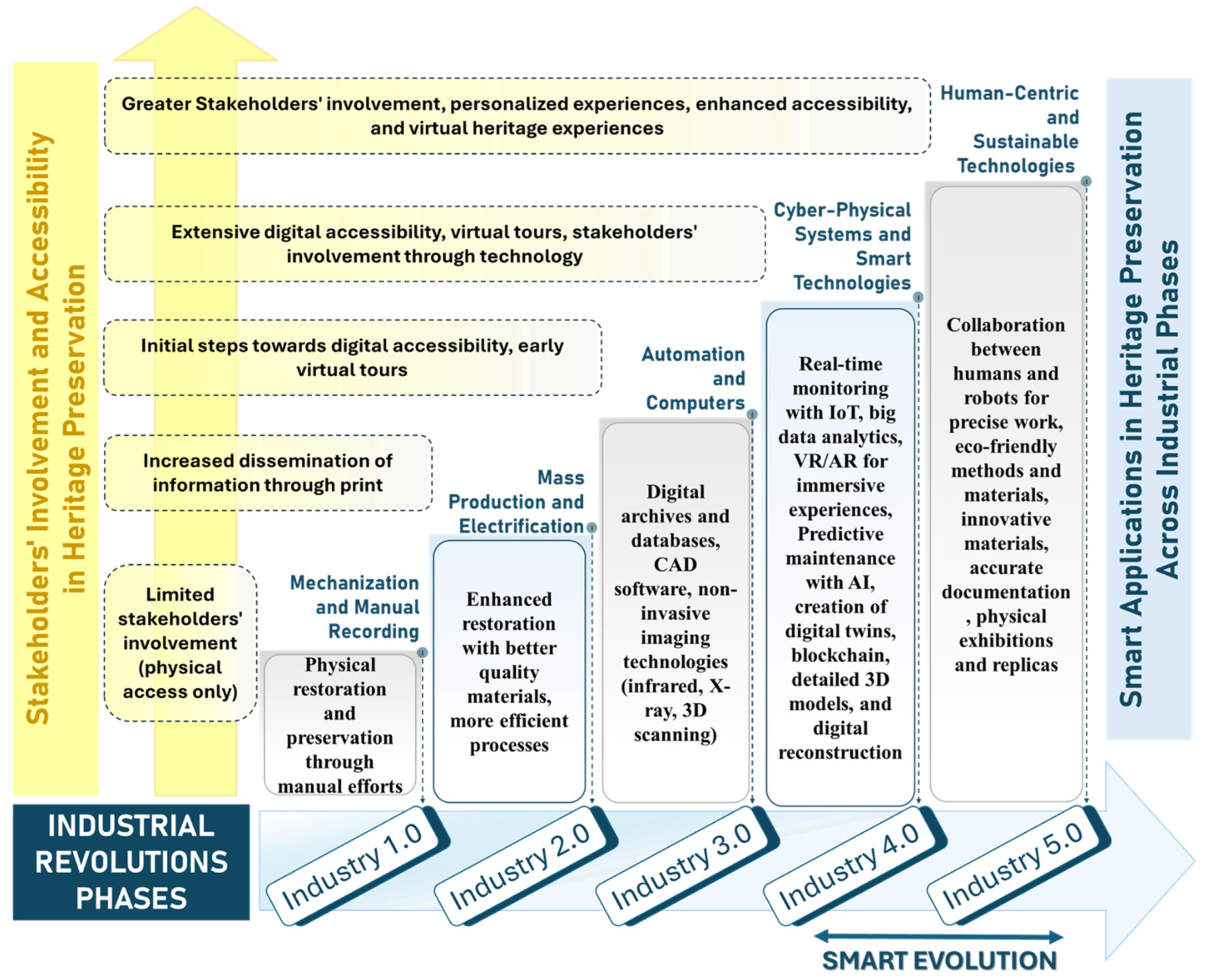
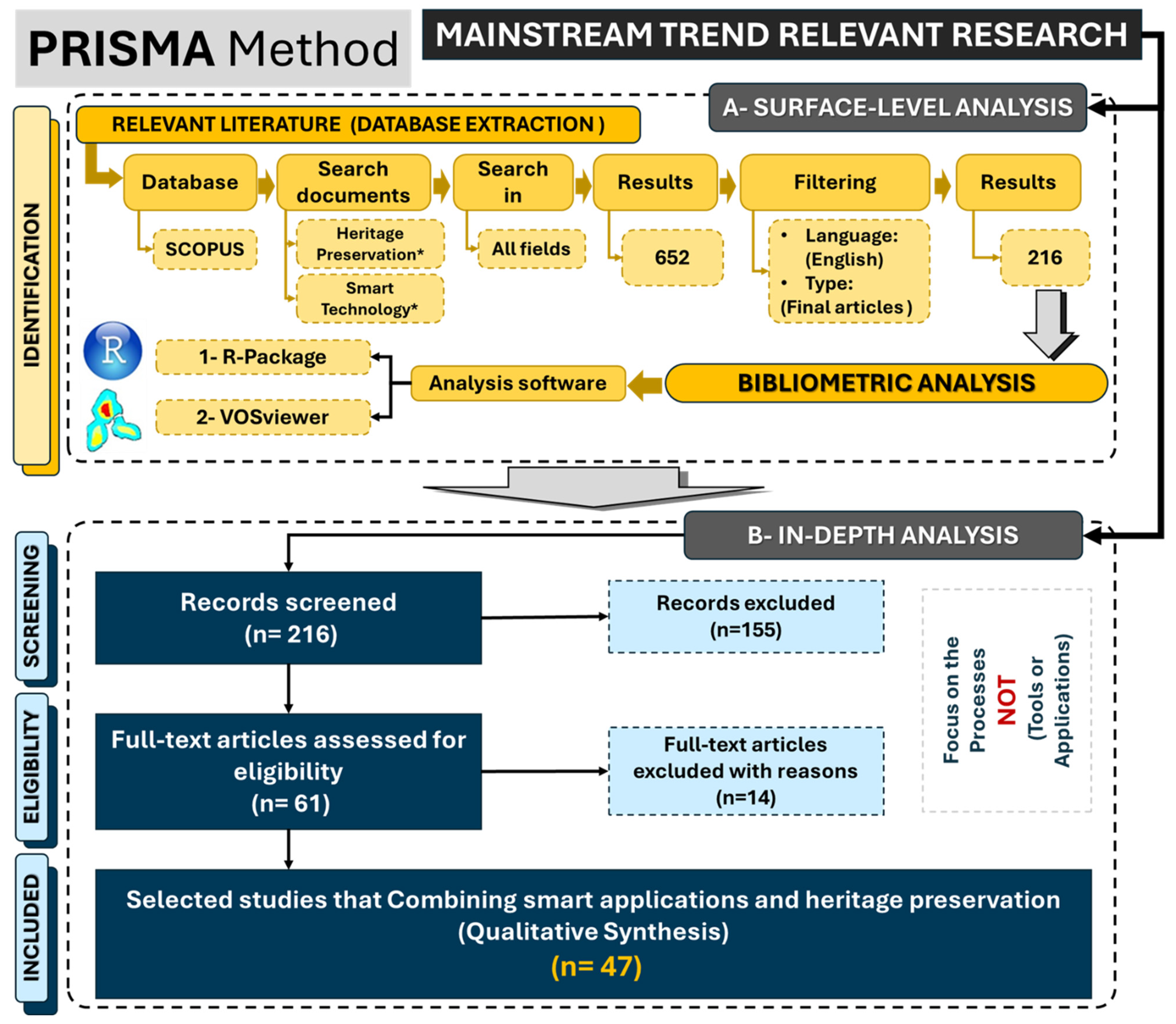
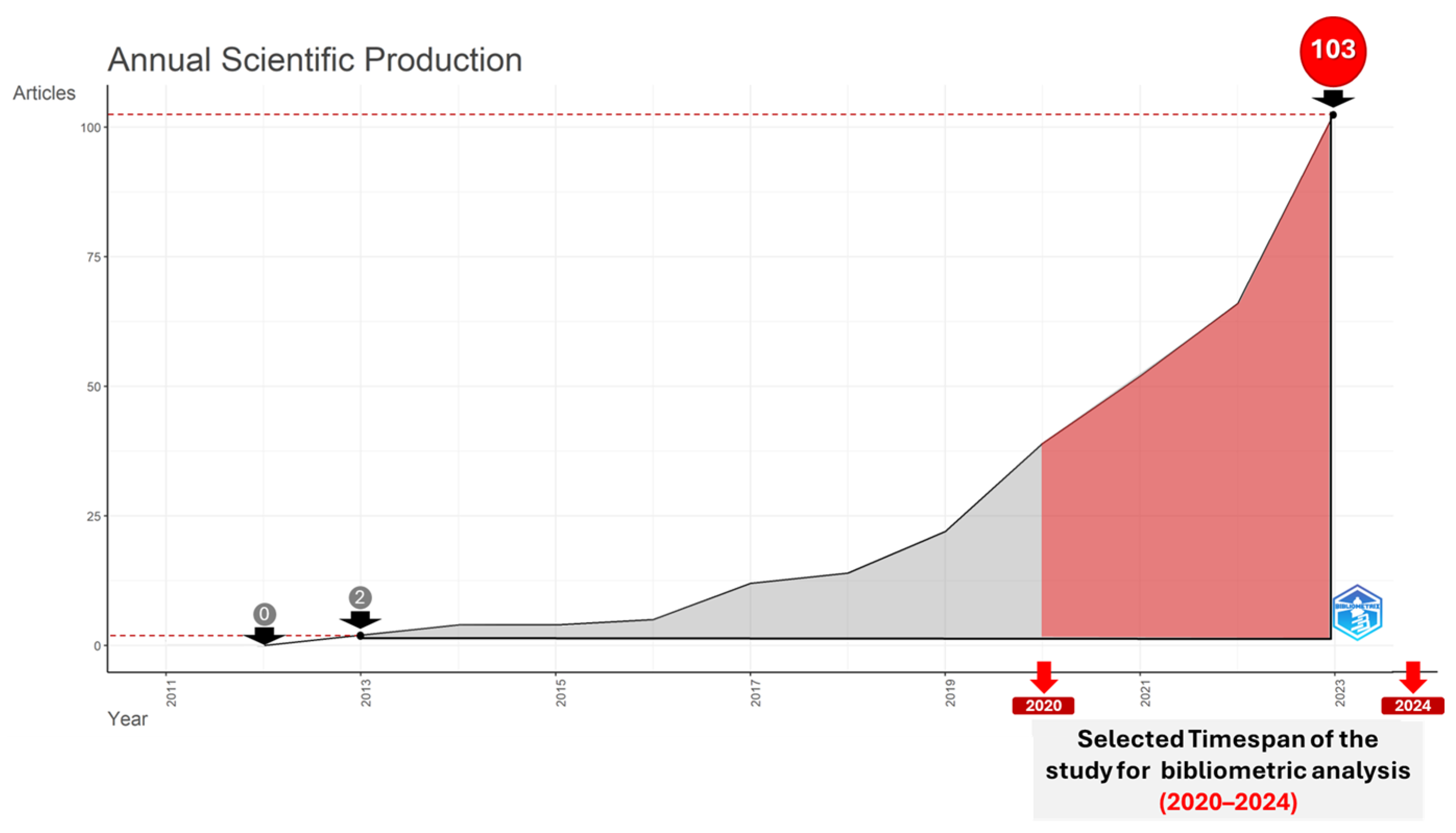


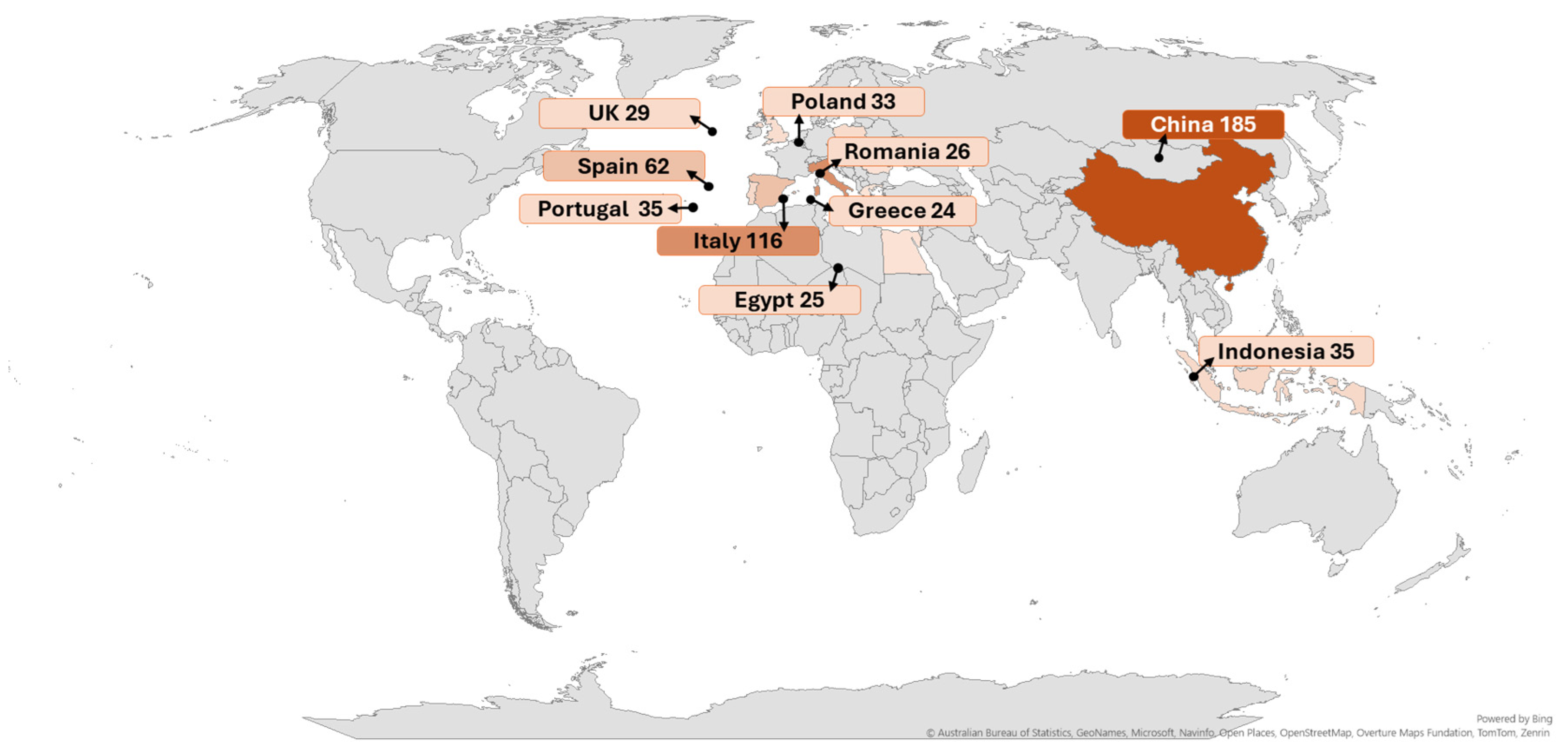
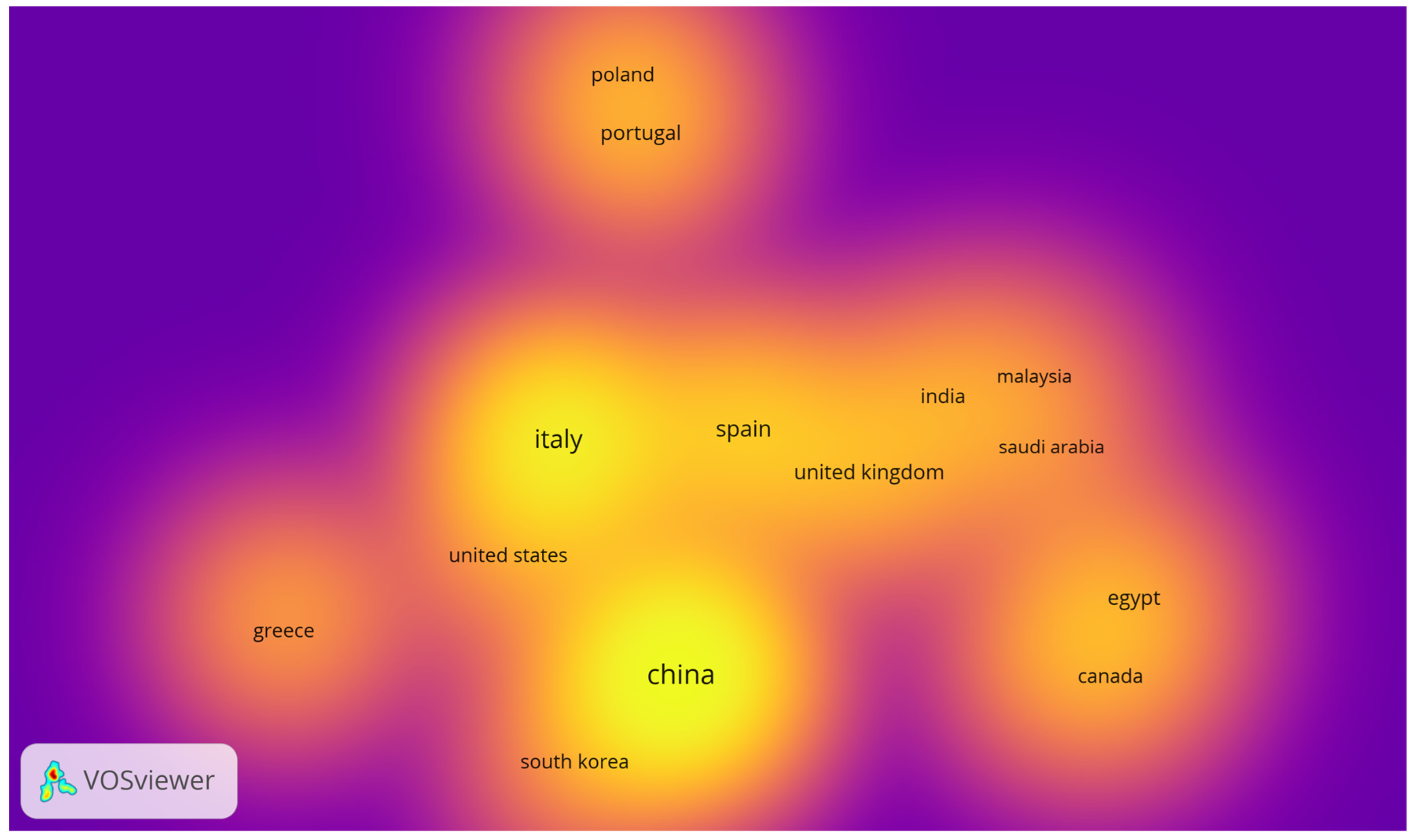
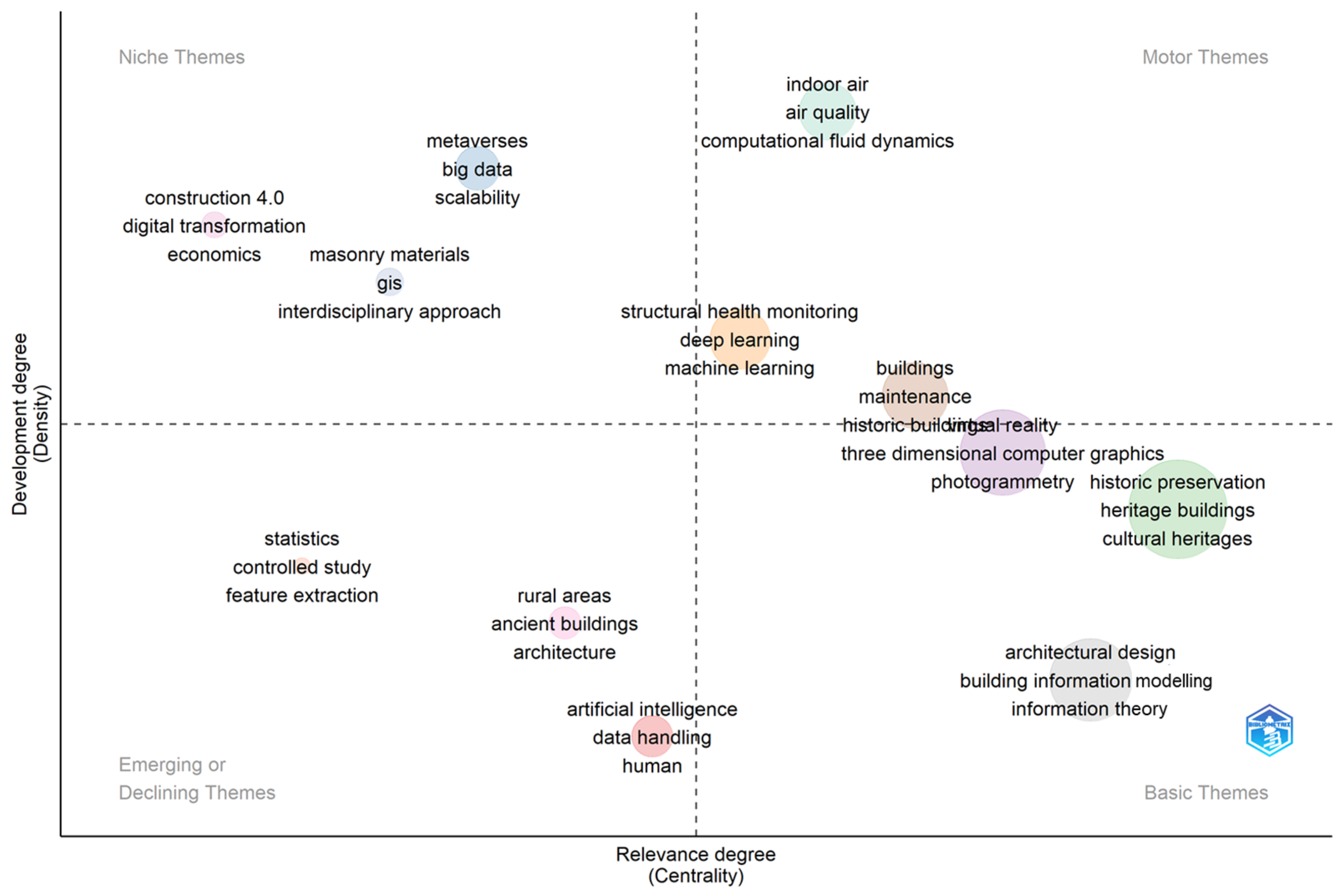
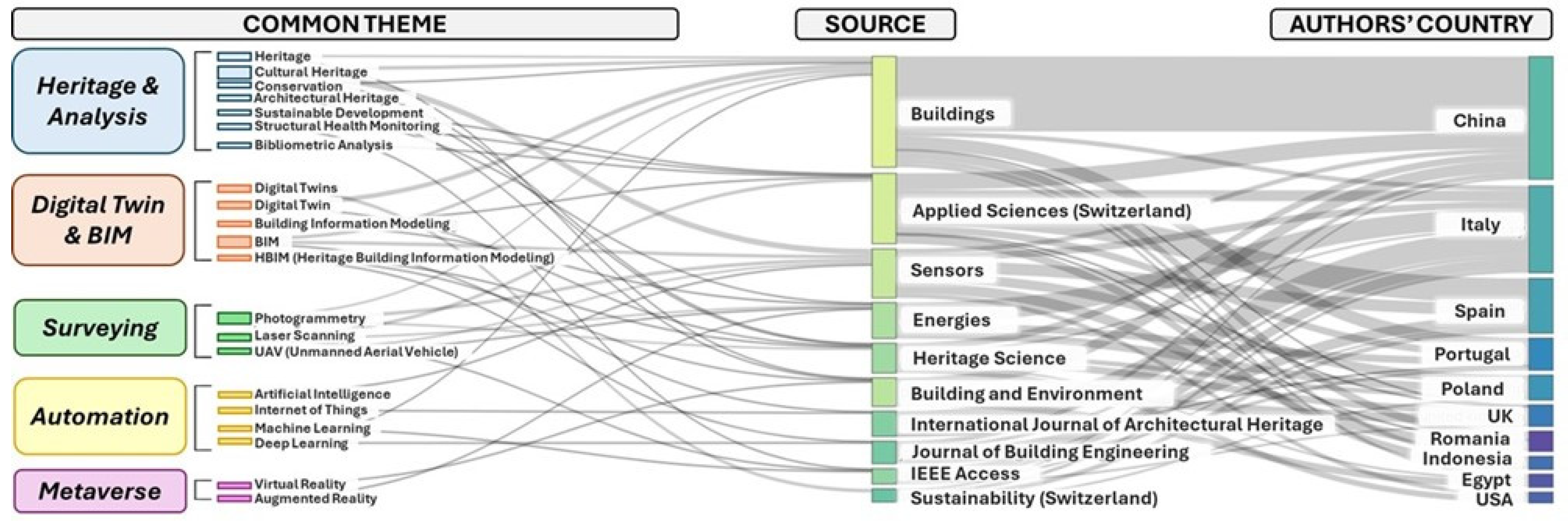
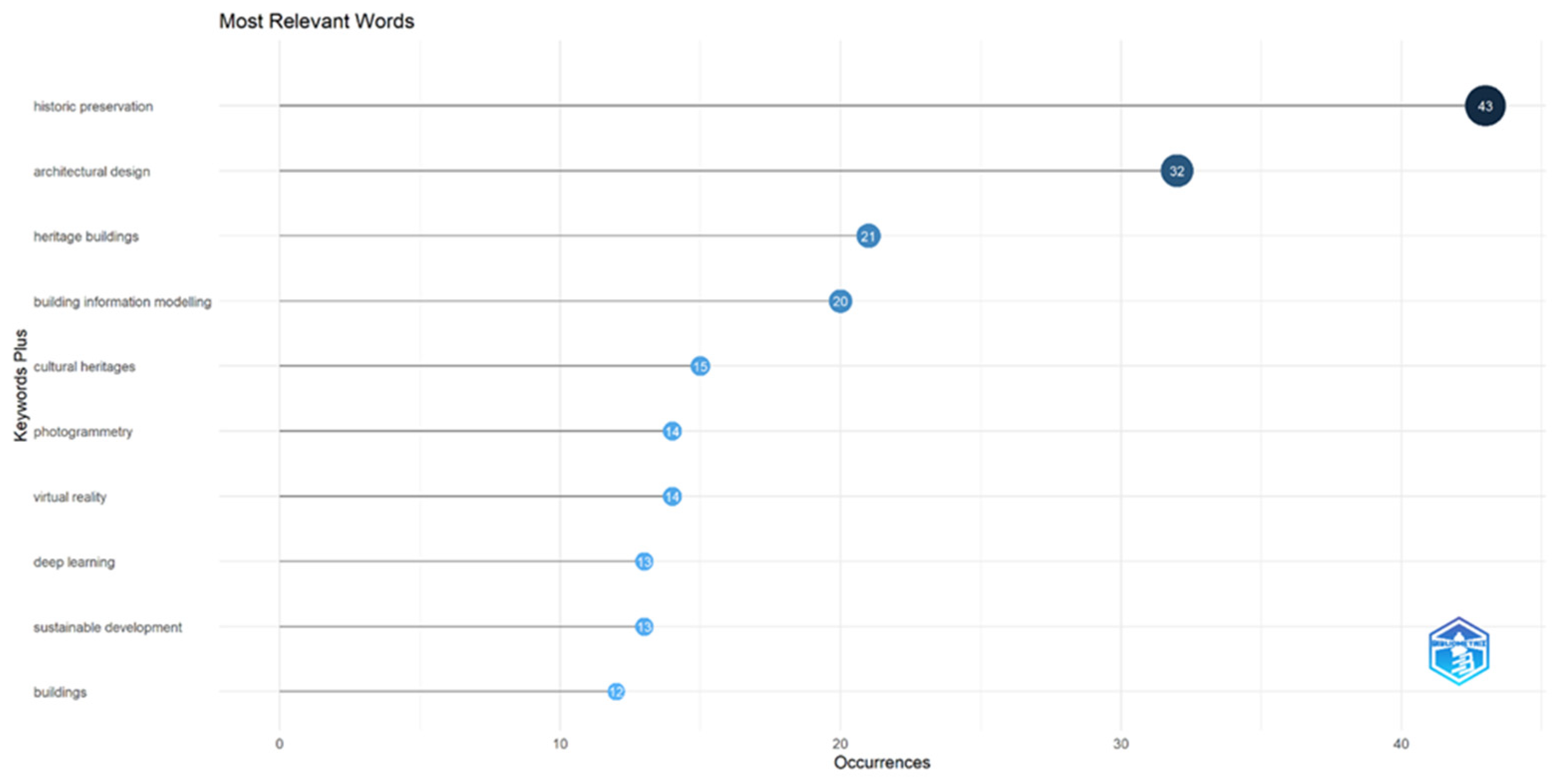


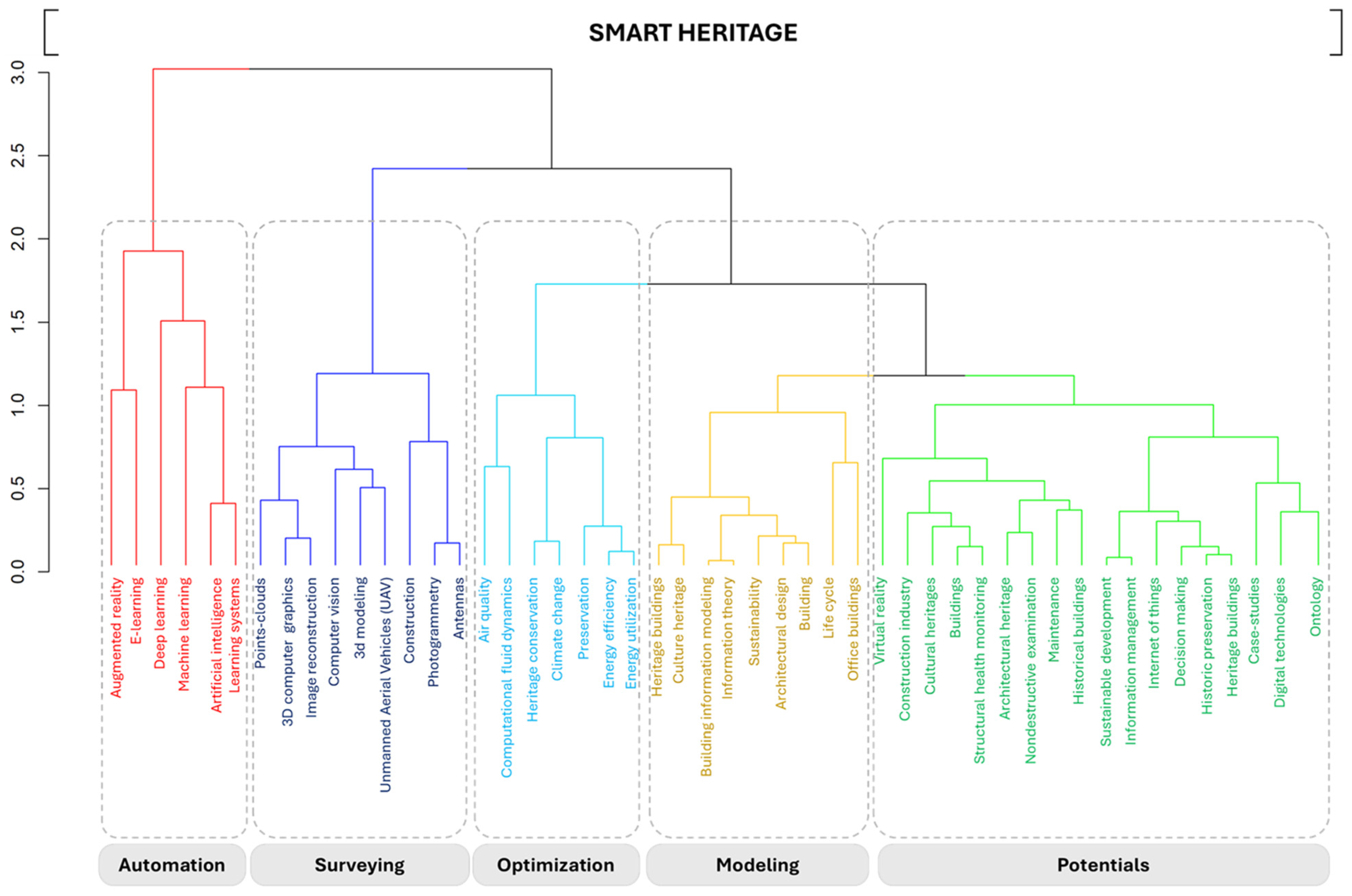

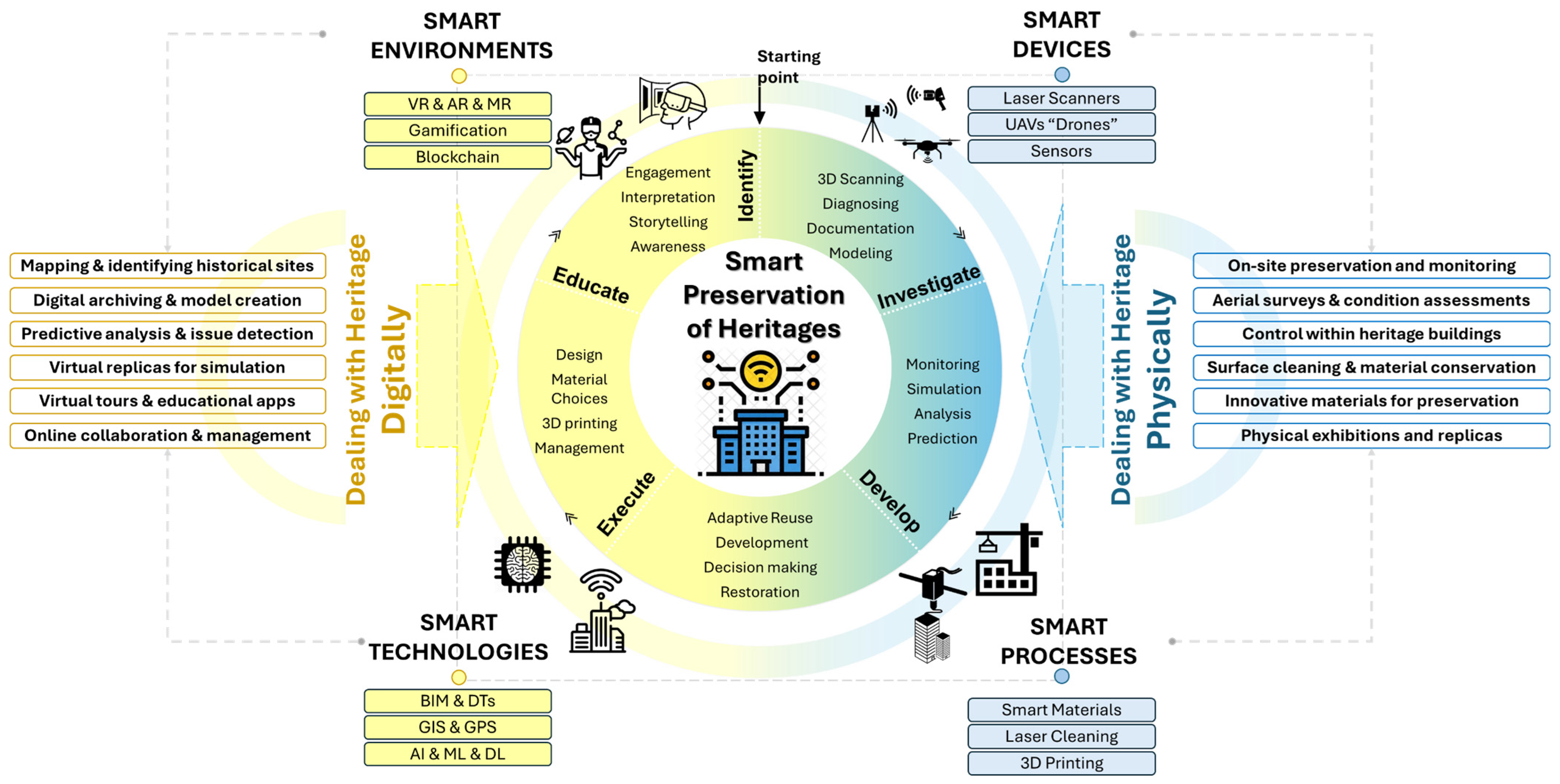
| Parameter | Details | Inclusion Criteria | Exclusion Criteria |
|---|---|---|---|
| Database | Scopus | - | - |
| Keywords | “heritage AND preservation” AND ALL (“digital AND heritage”) AND ALL (“smart AND city”) OR (“smart AND heritage”) AND (“buildings”) AND (“technology”) | Keywords aligned with heritage preservation and smart technologies | - |
| Fields | All fields | - | - |
| Subject area | Engineering | Engineering-related topics | Topics outside engineering |
| Time frame | 2020–2024 | Publications from 2020 onwards | Publications before 2020 |
| Language | English only | English language only | Non-English publications |
| Document type | Final articles only | Peer-reviewed journal articles | Non-final articles (e.g., conference abstracts, reviews) |
| Initial search results | 652 documents (as of 5 July 2024) | - | - |
| Documents after filters | 216 documents | Relevant documents on smart technology in heritage preservation | Irrelevant documents or duplicates |
| Description | Results |
|---|---|
| Main information about data | |
| Timespan | 2020:2024 |
| Documents | 216 |
| Annual growth rate % | 18.24 |
| Document average age | 1.66 |
| Average citations per doc | 13.28 |
| References | 14,852 |
| Document contents | |
| Keywords plus (id) | 1424 |
| Author’s keywords (de) | 891 |
| Authors | |
| Authors | 793 |
| Authors of single-authored docs | 8 |
| Author collaboration | |
| Single-authored docs | 8 |
| Co-authors per doc | 4.09 |
| International co-authorships % | 25.46 |
| Document types | |
| Article | 216 |
| N | Terms | Frequency |
|---|---|---|
| 1 | historic preservation | 43 |
| 2 | architectural design | 32 |
| 3 | heritage buildings | 21 |
| 4 | building information modelling | 20 |
| 5 | cultural heritages | 15 |
| 6 | photogrammetry | 14 |
| 7 | virtual reality | 14 |
| 8 | deep learning | 13 |
| 9 | sustainable development | 13 |
| 10 | buildings | 12 |
| N | Sources | Articles |
|---|---|---|
| 1 | Buildings | 28 |
| 2 | Applied Sciences | 23 |
| 3 | Sensors | 11 |
| 4 | Building and Environment | 8 |
| 5 | Energies | 8 |
| 6 | Heritage Science | 8 |
| 7 | IEEE Access | 8 |
| 8 | International Journal of Architectural Heritage | 6 |
| 9 | Journal of Building Engineering | 6 |
| 10 | Sustainability | 6 |
| N | Ref | Authors | Title | Year | Source Title | Total Citations | TC per Year | Normalized TC |
|---|---|---|---|---|---|---|---|---|
| 1 | [101] | Vargas J.C.G.; Fabregat R.; Carrillo-Ramos A.; Jové T. | Survey: Using augmented reality to improve learning motivation in cultural heritage studies | 2020 | Applied Sciences | 47 | 9.40 | 1.49 |
| 2 | [102] | Angulo-Fornos R.; Castellano-Román M. | HBIM as support of preventive conservation actions in heritage architecture. experience of the renaissance quadrant facade of the cathedral of seville | 2020 | Applied Sciences | 44 | 8.80 | 1.39 |
| 3 | [57] | Zhang X.; Yang D.; Yow C.H.; Huang L.; Wu X.; Huang X.; Guo J.; Zhou S.; Cai Y. | Metaverse for Cultural Heritages | 2022 | Electronics | 42 | 14.00 | 1.38 |
| 4 | [68] | Bacco M.; Barsocchi P.; Cassara P.; Germanese D.; Gotta A.; Leone G.R.; Moroni D.; Pascali M.A.; Tampucci M. | Monitoring Ancient Buildings: Real Deployment of an IoT System Enhanced by UAVs and Virtual Reality | 2020 | IEEE Access | 40 | 8.00 | 1.27 |
| 5 | [103] | Moyano J.; Gil-Arizón I.; Nieto-Julián J.E.; Marín-García D. | Analysis and management of structural deformations through parametric models and HBIM workflow in architectural heritage | 2022 | Journal of Building Engineering | 38 | 12.67 | 1.25 |
| 6 | [104] | Skrzypczak I.; Oleniacz G.; Leśniak A.; Zima K.; Mrówczyńska M.; Kazak J.K. | Scan-to-BIM method in construction: assessment of the 3D buildings model accuracy in terms inventory measurements | 2022 | Building Research and Information | 38 | 12.67 | 1.25 |
| 7 | [105] | Ma Y.-P. | Extending 3D-GIS District Models and BIM-Based Building Models into Computer Gaming Environment for Better Workflow of Cultural Heritage Conservation | 2021 | Applied Sciences | 37 | 9.25 | 2.70 |
| 8 | [106] | Templin T.; Popielarczyk D. | The Use of Low-Cost Unmanned Aerial Vehicles in the Process of Building Models for Cultural Tourism, 3D Web and Augmented/Mixed Reality Applications | 2020 | Sensors | 36 | 7.20 | 1.14 |
| 9 | [107] | Palomar I.J.; García Valldecabres J.L.; Tzortzopoulos P.; Pellicer E. | An online platform to unify and synchronise heritage architecture information | 2020 | Automation in Construction | 36 | 7.20 | 1.14 |
| 10 | [108] | Marra A.; Gerbino S.; Greco A.; Fabbrocino G. | Combining Integrated Informative System and Historical Digital Twin for Maintenance and Preservation of Artistic Assets | 2021 | Sensors | 35 | 8.75 | 2.55 |
| N | Country | Number of Publications |
|---|---|---|
| 1 | China | 185 |
| 2 | Italy | 116 |
| 3 | Spain | 62 |
| 4 | Indonesia | 35 |
| 5 | Portugal | 35 |
| 6 | Poland | 33 |
| 7 | UK | 29 |
| 8 | Romania | 26 |
| 9 | Egypt | 25 |
| 10 | Greece | 24 |
| Aspect | Details |
|---|---|
| Keywords used | Authors’ keywords explicitly provided in the publications. |
| Total keywords | 891 keywords. |
| Co-occurrence filter | Minimum co-occurrence threshold: 2 occurrences. Keywords appearing less frequently were excluded. |
| Keyword frequency (top keywords) |
|
| |
| |
| |
|
| Ref. | Year | Source | Study Type | Research Aim | Smart Application | Approach |
|---|---|---|---|---|---|---|
| [117] | 2020 | Energies | applied study | To use H-BIM to implement system for energy refurbishment. | H-BIM | Digitally |
| [118] | 2020 | Engineering, Construction and Architectural Management | analytical study | To explore the adoption of historic building information modeling (HBIM) in managing built heritage. | H-BIM | Digitally |
| [119] | 2020 | Smart Infrastructure and Construction | applied study | To explore the use of resource description framework literals in a built heritage context. | H-BIM | Digitally |
| [102] | 2020 | Applied Sciences | applied study | To explore the use of H-BIM for managing heritage information for cultural asset preservation. | H-BIM | Digitally |
| [101] | 2020 | Applied Sciences | analytical study | To explore the use of augmented reality (AR) in cultural heritage education to enhance the learning experience. | AR | Digitally |
| [68] | 2020 | IEEE Access | applied study | To propose an IoT architecture with virtual reality for a remote monitoring system for historical buildings. | IOT, VR | Digitally |
| [120] | 2020 | Building Research and Information | literature review + analytical study | To present a piece of literature on structural health monitoring (SHM) for historic building preservation and new structure design. | N/A | Physically |
| [106] | 2020 | Sensors | analytical study + applied study | To present a universal methodology for inventorying historical buildings using UAVs and the potential of 3D models focusing on Web/AR/MR/VR technology. | UAV, Web/AR/MR/VR technology | Digitally and physically |
| [121] | 2020 | Sensors | applied study | To use infrared thermography to automatically monitor cultural heritage elements and detect thermal footprints. | Infrared thermography | Physically |
| [105] | 2021 | Applied Sciences | applied study | To investigate the application of game technology in incorporating historical building models and 3D-GIS to attribute data into a virtual reality simulation for heritage conservation. | 3D-GIS, gamification, VR | Digitally |
| [122] | 2021 | Applied Geomatics | applied study | To present a new methodology for digitizing cultural heritage through H-BIM. | H-BIM | Digitally |
| [123] | 2021 | Developments in the Built Environment | applied study | To use H-BIM and big data and smart sensing for monitoring and visualization. | H-BIM | Digitally |
| [108] | 2021 | Sensors | applied study | To present a comprehensive digital approach to the preservation and protection of artistic and cultural heritage. | DT | Digitally |
| [124] | 2021 | Drones | applied study | To present a case study of the development of a hyper-realistic 3D model of heritage building, using unmanned aerial vehicles (UAV). | UAV | Physically |
| [125] | 2021 | Engineering Structures | applied study | To investigates retrofitting irregular steel joints in traditional Chinese buildings to enhance strength while preserving historical architectural heritage. | Smart materials | Physically |
| [126] | 2021 | Studies in Conservation | applied study | To explore the use of conservators’ unique materials and heritage experience for heritage preservation, focusing on cleaning and repair rather than replacement. | Laser cleaning | Physically |
| [127] | 2022 | Smart and Sustainable Built Environment | literature review | To review 354 articles on BIM and provide key priorities for future research. | BIM and digital technologies | Digitally |
| [128] | 2022 | Buildings | applied study | To present a method for using digital twin, ensuring consistency and avoiding information loss and dispersion issues. | DT | Digitally |
| [129] | 2022 | Journal of Information Technology in Construction | analytical study + applied study | To improve the digital transformation of the construction sector by integrating cultural and architectural heritage conservation management. | DT, VR | Digitally |
| [130] | 2022 | Journal of Imaging | applied study | To assess the use of low-cost sensors in the photogrammetric field for digitizing cultural heritage. | Spherical camera photogrammetry, sensors | Physically |
| [131] | 2023 | IoT | analytical study | To establish a method for long-term storage of digital twins | DT | Digitally |
| [132] | 2023 | Buildings | analytical study | To integrate BIM with heritage preservation | BIM | Digitally |
| [133] | 2023 | Buildings | applied study | To present an IoT BIM-based solution for real-time monitoring of built cultural heritage using low-cost sensors. | IOT, BIM | Digitally |
| [134] | 2023 | Buildings | literature review | To drive sustainable design and development using BIM | BIM | Digitally |
| [135] | 2023 | Sensors | applied study | To propose a 3D model-associated informative tool and a priority index. | BIM and H-BIM | Digitally |
| [136] | 2023 | Automation in Construction | literature review | To explore the application of digital twins in heritage construction. | DT, H-BIM, IOT | Digitally |
| [137] | 2023 | Buildings | applied study | To explore the implementation of BIM in a complex renovation project. | BIM | Digitally |
| [80] | 2023 | International Journal of Architectural Heritage | applied study | To explore the benefits of multi-scale digitization for architectural renovation and energy upgrades. | H-BIM | Digitally |
| [138] | 2023 | Italian Journal of Planning Practice | applied study | To utilize BIM and GIS technologies to preserve historic districts through field surveys, digital mapping, and GIS integration. | BIM, GIS | Digitally |
| [139] | 2023 | Automation in Construction | applied study | To present a method for health monitoring of historic structures using photogrammetry technologies and point cloud processing algorithms, as well as virtual models. | DT, photogrammetry | Digitally and physically |
| [140] | 2023 | Buildings | applied study | To use explainable artificial intelligence (XAI) to create accurate models of ancient architecture and lacquer art. | XAI | Digitally |
| [141] | 2023 | Energies | applied study | To present research on machine learning applications for remote monitoring of historic buildings and create an online HBIM platform for urban monitoring. | ML, HBIM | Digitally |
| [30] | 2023 | Applied Sciences (Switzerland) | applied study | To define the role of the three-dimensional scanning and 3D printing in cultural heritage preservation. | 3D scanning, 3D printing | Physically |
| [142] | 2023 | Buildings | applied study | To document vernacular heritage buildings in 3D using photogrammetry and laser scanner technology. | Photogrammetry and laser scanner | Physically |
| [143] | 2023 | Buildings | applied study | To establish a virtual model for the conservation through efficient sensors. | Sensor, DT | Digitally and physically |
| [144] | 2023 | Advances in Science and Technology Research Journal | applied study | To showcase the potential of advanced geodetic techniques for research, preservation, and heritage documentation. | Photogrammetry, digital cameras, sensors | Physically |
| [145] | 2023 | Journal of the International Measurement Confederation | applied study | To propose a new methodology using a smartphone and LiDAR terrestrial laser scanners to examine wall cracks and displacement. | Smartphone, terrestrial laser scanners (LiDAR scanners) | Physically |
| [146] | 2023 | Drones | applied study | To use scan-to-HBIM-to-XR process and UAV photogrammetry to enhance the depiction of archaeological ruins and enhance opportunities. | UAV photogrammetry, H-BIM, XR | Digitally and physically |
| [133] | 2023 | Buildings | applied study | To present an IoT BIM-based solution for real-time monitoring of built cultural heritage using low-cost sensors. | Sensors | Physically |
| [147] | 2023 | Construction and Building Materials | applied study | To present an experimental investigation of smart intervention materials for historic masonry structures. | Smart materials | Physically |
| [148] | 2023 | Applied Physics A | analytical study | To explore femtosecond laser cleaning for historic monument materials, while preserving substrate integrity. | Laser cleaning | Physically |
| [149] | 2024 | Construction Innovation | analytical study + applied study | To assess and simulate renovation scenarios in terms of duration, cost, effort, and disruptive potential. | BIM | Digitally |
| [150] | 2024 | Applied Mathematics and Nonlinear Sciences | applied study | To explore the impact of virtual reality (VR) on tourism in cultural heritage sites. | VR | Digitally |
| [151] | 2024 | Applied Sciences | applied study | To explore the integration of game mini-map navigation design elements into online virtual museums for enhancing virtual experiences. | Gamification | Digitally |
| [152] | 2024 | Applied Sciences (Switzerland) | applied study | To develop a BIM-based system for managing repair history. | BIM | Digitally |
| [153] | 2024 | IEEE Access | analytical study | To explore the role of blockchain in creating and managing the Metaverse platform. | Blockchain, Metaverse | Digitally |
| [154] | 2024 | Journal of Building Engineering | applied study | To investigate the use of unmanned aerial vehicle photogrammetry for rapid structural inspections of cultural heritage and demonstrate the potential of AI in this process. | UAV photogrammetry, AI | Digitally and physically |
| Research Area (Relevant Trends) | Objective | No. Documents | Percentage |
|---|---|---|---|
| Interoperability and integration | Ensure seamless technology integration | 45 | 21% |
| Advanced monitoring and predictive maintenance | Improve monitoring and preventive care | 40 | 18% |
| Data management and cybersecurity | Data management and enhanced security | 24 | 11% |
| Cost reduction and affordable models | Lower costs and affordable technologies | 23 | 11% |
| Enhanced documentation and accessibility | Improve digital records and public engagement | 18 | 8% |
| Futureproofing and sustainability | Ensure long-term relevance and sustainability | 15 | 7% |
| Cultural and community engagement | Involve and respect local communities | 14 | 6% |
| Specialized topics that cannot be generalized | Various objectives | 12 | 6% |
| Balancing preservation and modernization | Integrate modern tech without compromising authenticity | 10 | 5% |
| Resilience to environmental changes | Adapt to climate change and environmental impacts | 10 | 5% |
| Skill development and training | Build expertise in smart technologies | 5 | 2% |
| Research Area | Key Benefits | Challenges | Future Research | Stakeholders |
|---|---|---|---|---|
| Interoperability and integration | Smooth technology adoption Reduced technical disruptions | Technical complexity Integration issues | Standardization of IoT communication protocols Modular plug-and-play (PnP) heritage monitoring systems | Technology developers Heritage site managers |
| Advanced monitoring and predictive maintenance | Proactive preservation Extended lifespan of heritages | Ineffective monitoring High maintenance costs | AI-driven predictive maintenance models Development of advanced sensors for monitoring | AI specialists Heritage conservationists |
| Data management and cybersecurity | Enhanced data transfer Reduced risk of cyberattacks | Data transfer Cybersecurity risks | AI-driven cybersecurity systems for heritage sites Blockchain for data management in heritage preservation | IT experts Heritage managers |
| Cost reduction and affordable models | Broader implementation of smart technologies Enhanced financial sustainability | High initial costs | Developing low-cost sensors and IoT devices | Government agencies |
| Enhanced documentation and accessibility | Comprehensive digital archives Global accessibility Enhanced educational value | Limited documentation Accessibility issues | Advanced 3D scanning projects VR and AR applications for virtual tours of heritages | VR/AR developers Heritage educators |
| Futureproofing and sustainability | Long-term viability of technology investments Reduced environmental impact | Technological obsolescence, environmental impact | Development of scalable, adaptable tech solutions Sustainable practices in heritages | Environmental experts Technology developers |
| Cultural and community engagement | Greater community involvement Culture and technology integration | Cultural considerations Community acceptance | Community-led tech integration projects in heritage preservation | Local communities Cultural experts |
| Balancing preservation and modernization | Synergy of technology and heritage | Preservation vs. modernization balance | Guidelines for integrating smart tech in historic buildings | Heritage conservationists Architects |
| Resilience to environmental changes | Increased resilience to climate impacts Proactive environmental management | Vulnerability to environmental changes Climate adaptation needs | Climate adaptation heritage strategies Advanced environmental monitoring systems for heritages | Environmental specialists Climate experts |
| Skill development and training | Increased technical proficiency Efficient use of smart technologies Empowered staff | Skill gaps Training requirements | User-friendly software for heritage preservation | Educational institutions Heritage organizations Technology providers |
Disclaimer/Publisher’s Note: The statements, opinions and data contained in all publications are solely those of the individual author(s) and contributor(s) and not of MDPI and/or the editor(s). MDPI and/or the editor(s) disclaim responsibility for any injury to people or property resulting from any ideas, methods, instructions or products referred to in the content. |
© 2024 by the authors. Licensee MDPI, Basel, Switzerland. This article is an open access article distributed under the terms and conditions of the Creative Commons Attribution (CC BY) license (https://creativecommons.org/licenses/by/4.0/).
Share and Cite
Shehata, A.O.; Noroozinejad Farsangi, E.; Mirjalili, S.; Yang, T.Y. A State-of-the-Art Review and Bibliometric Analysis on the Smart Preservation of Heritages. Buildings 2024, 14, 3818. https://doi.org/10.3390/buildings14123818
Shehata AO, Noroozinejad Farsangi E, Mirjalili S, Yang TY. A State-of-the-Art Review and Bibliometric Analysis on the Smart Preservation of Heritages. Buildings. 2024; 14(12):3818. https://doi.org/10.3390/buildings14123818
Chicago/Turabian StyleShehata, Alaa O., Ehsan Noroozinejad Farsangi, Seyedali Mirjalili, and T. Y. Yang. 2024. "A State-of-the-Art Review and Bibliometric Analysis on the Smart Preservation of Heritages" Buildings 14, no. 12: 3818. https://doi.org/10.3390/buildings14123818
APA StyleShehata, A. O., Noroozinejad Farsangi, E., Mirjalili, S., & Yang, T. Y. (2024). A State-of-the-Art Review and Bibliometric Analysis on the Smart Preservation of Heritages. Buildings, 14(12), 3818. https://doi.org/10.3390/buildings14123818








